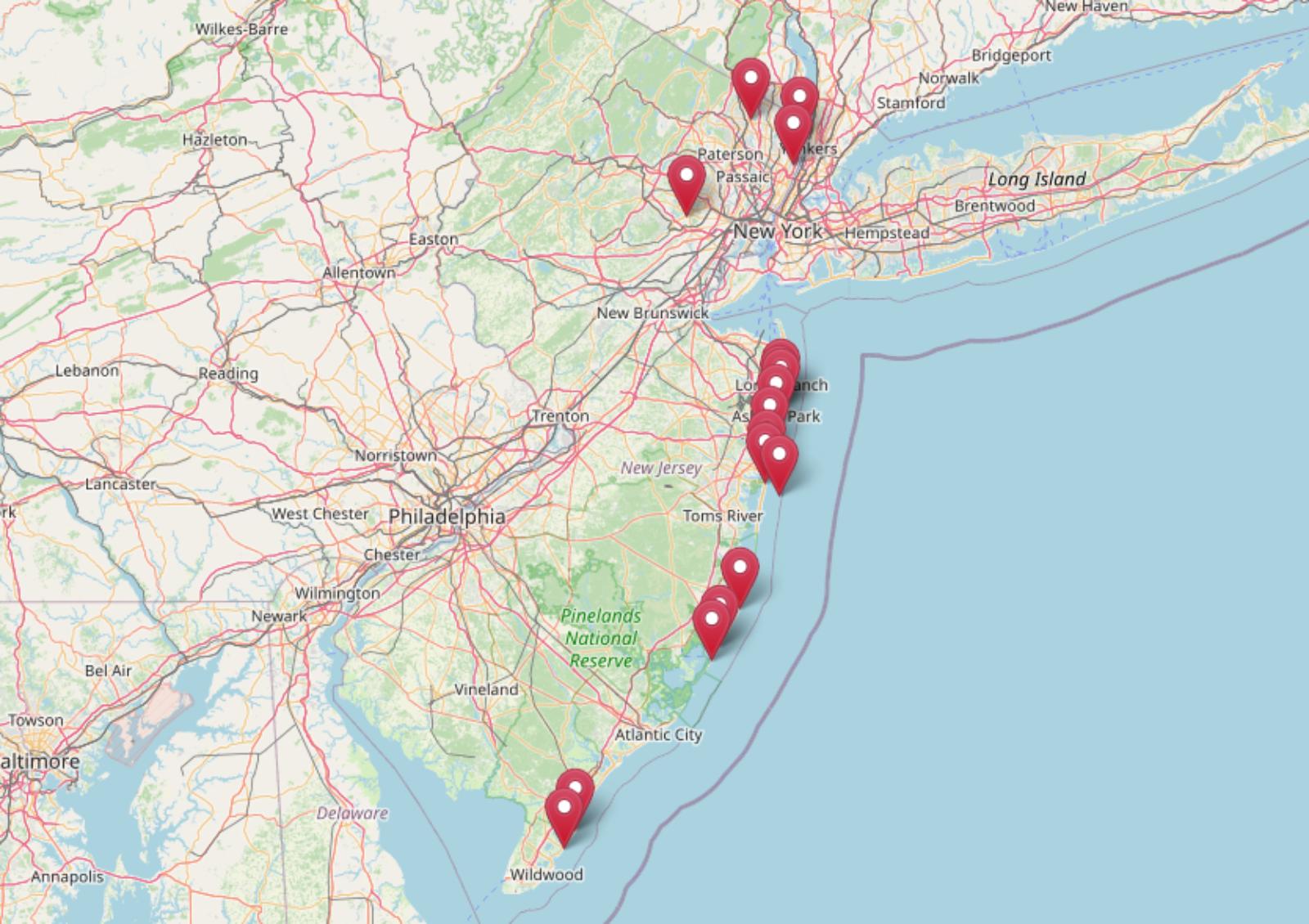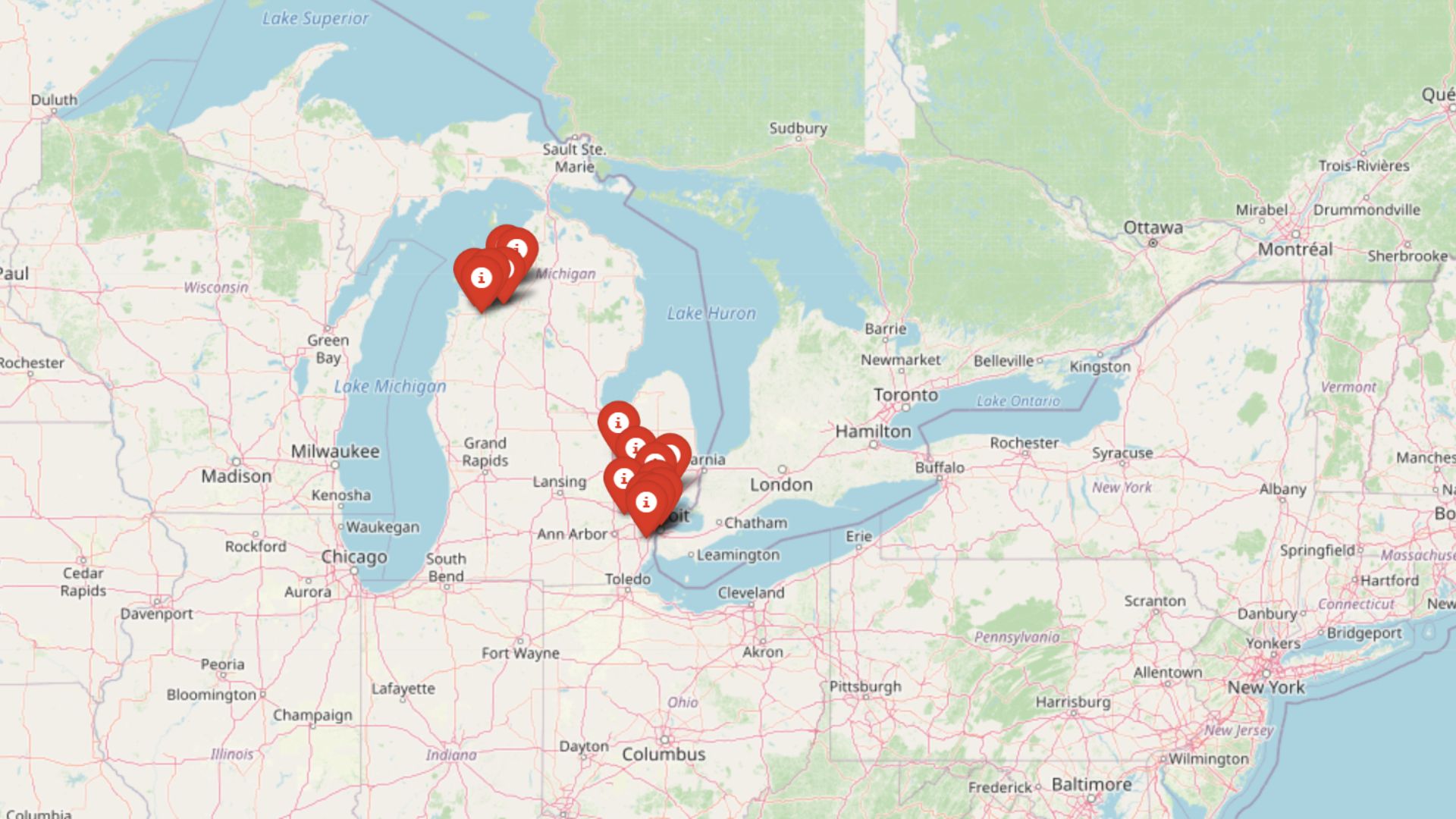Retiring in Virginia might sound idyllic—think rolling hills, historic charm, and peaceful living—but the 2025 Overall Retirement Score (ORS) tells a different story in some towns. The data points to 18 places where life after 65 gets harder, not easier.
Whether it’s the lack of walkable streets, weak transit, or just too little going on, these towns score lowest in the state for retirement readiness. If you’re eyeing the Old Dominion for your golden years, this list could help you sidestep some not-so-golden choices.
18. Prince George – Few Conveniences for Aging Residents
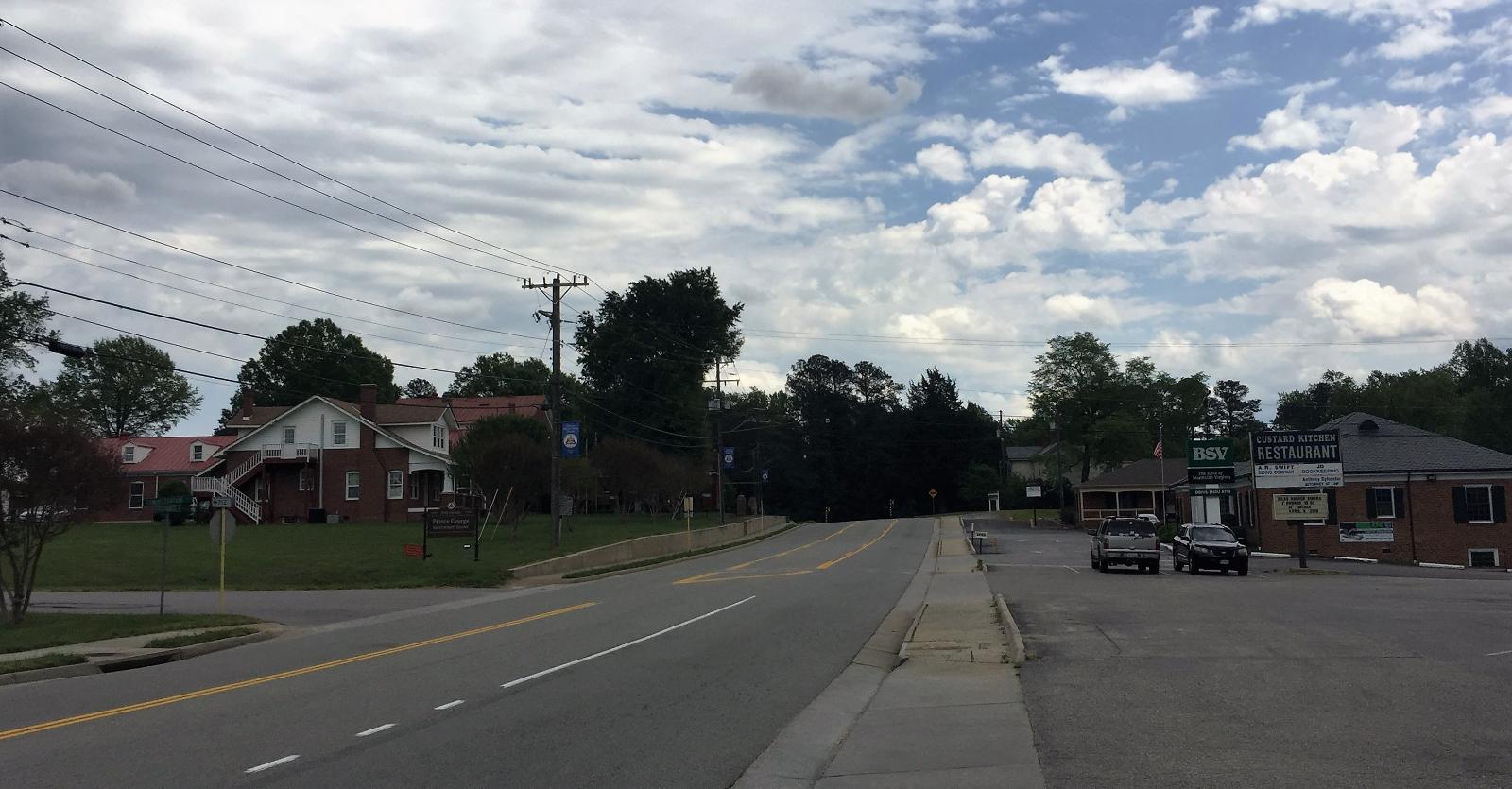
Prince George sits in southeastern Virginia, just south of the James River and east of Petersburg. While it’s known for its suburban quiet and proximity to military bases, it lacks key features retirees often look for—like vibrant community hubs, medical access, and recreational infrastructure. The area is car-dependent, with limited public transportation and low walkability, which can make daily life harder for older adults who don’t drive.
The town is better suited to working families or military personnel stationed nearby. Despite being peaceful, it’s not especially welcoming for those seeking engaging, accessible retirement living. Social opportunities and cultural amenities are scarce, and for retirees wanting more than just a quiet place to sit, Prince George may feel isolating.
Prince George – ORS 20.11

- Overall Retirement Score: 20.11
- Quietness: 74.58
- Walkability: 5.41
- Cultural amenities: 3.47
- Vibrancy: 5.57
- Car-Friendliness: 86.91
- Transit-Friendliness: 6.31
With an ORS of just 20.11, Prince George’s retirement appeal is limited. High car-dependence, minimal walkability, and a serious lack of cultural offerings make it a tough choice for anyone looking for an enriching retirement lifestyle. While it’s quiet, that quiet comes at a cost.
17. Quantico – Restricted Access and Sparse Amenities

Quantico is unique—most of it is located on a Marine Corps base, which brings a level of access restriction and a military-first atmosphere that doesn’t lend itself well to civilian retirement living. It’s located in northern Virginia, close to the Potomac River, but public amenities are limited, and the feel is less residential and more institutional.
This isn’t a place designed for retirees looking for community and comfort. Services are geared toward military families, and off-base development is minimal. For older adults, that can translate to limited access to grocery stores, health services, or simple conveniences like cafes or social clubs.
Quantico – ORS 14.44
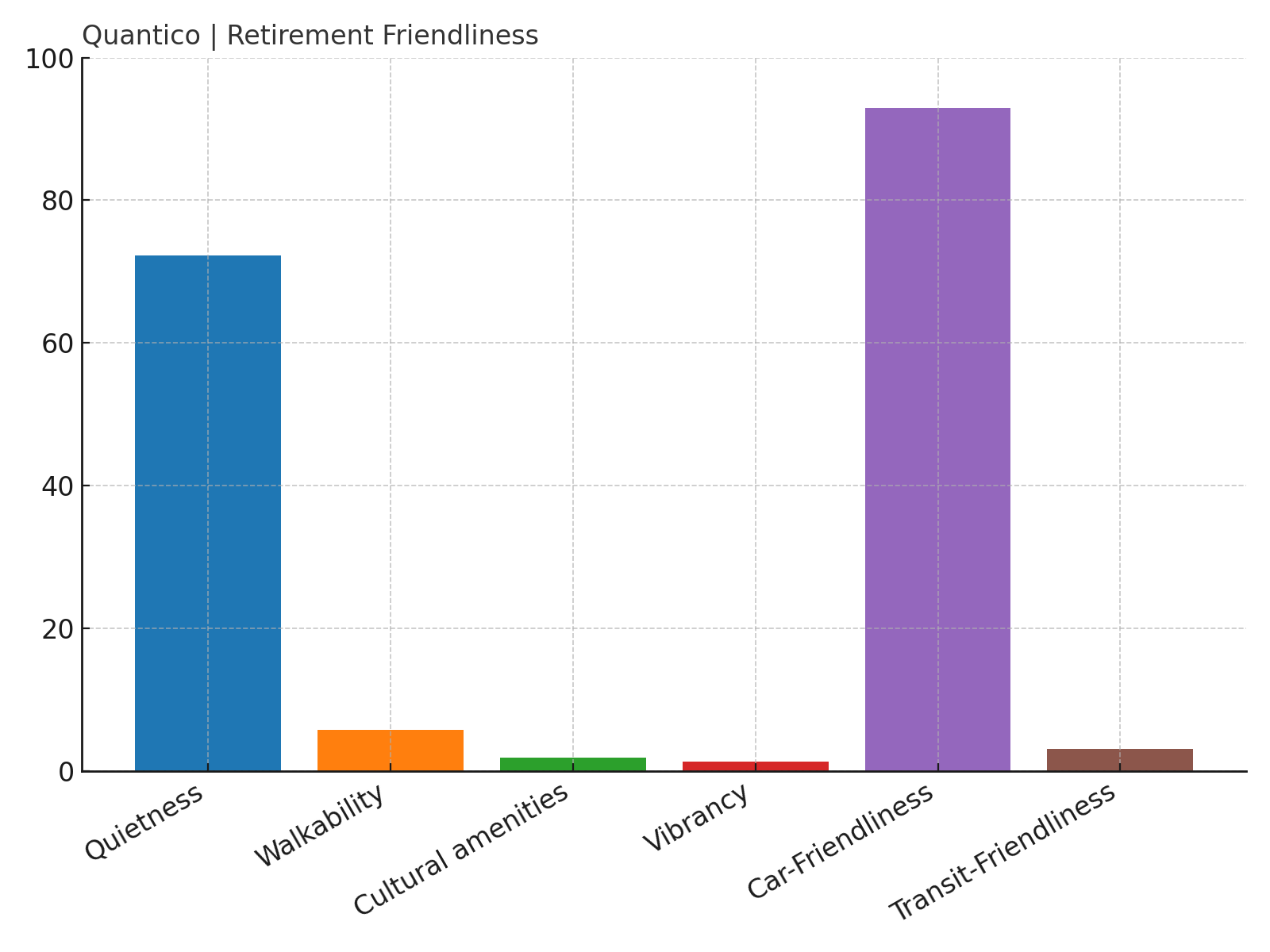
- Overall Retirement Score: 14.44
- Quietness: 72.27
- Walkability: 5.75
- Cultural amenities: 1.83
- Vibrancy: 1.28
- Car-Friendliness: 92.94
- Transit-Friendliness: 3.13
Quantico’s ORS of 14.44 reflects the town’s lack of civilian infrastructure. With minimal vibrancy, poor walkability, and low cultural access, it ranks among Virginia’s least favorable retirement destinations in 2025.
16. Wallops Island – Isolation Over Convenience
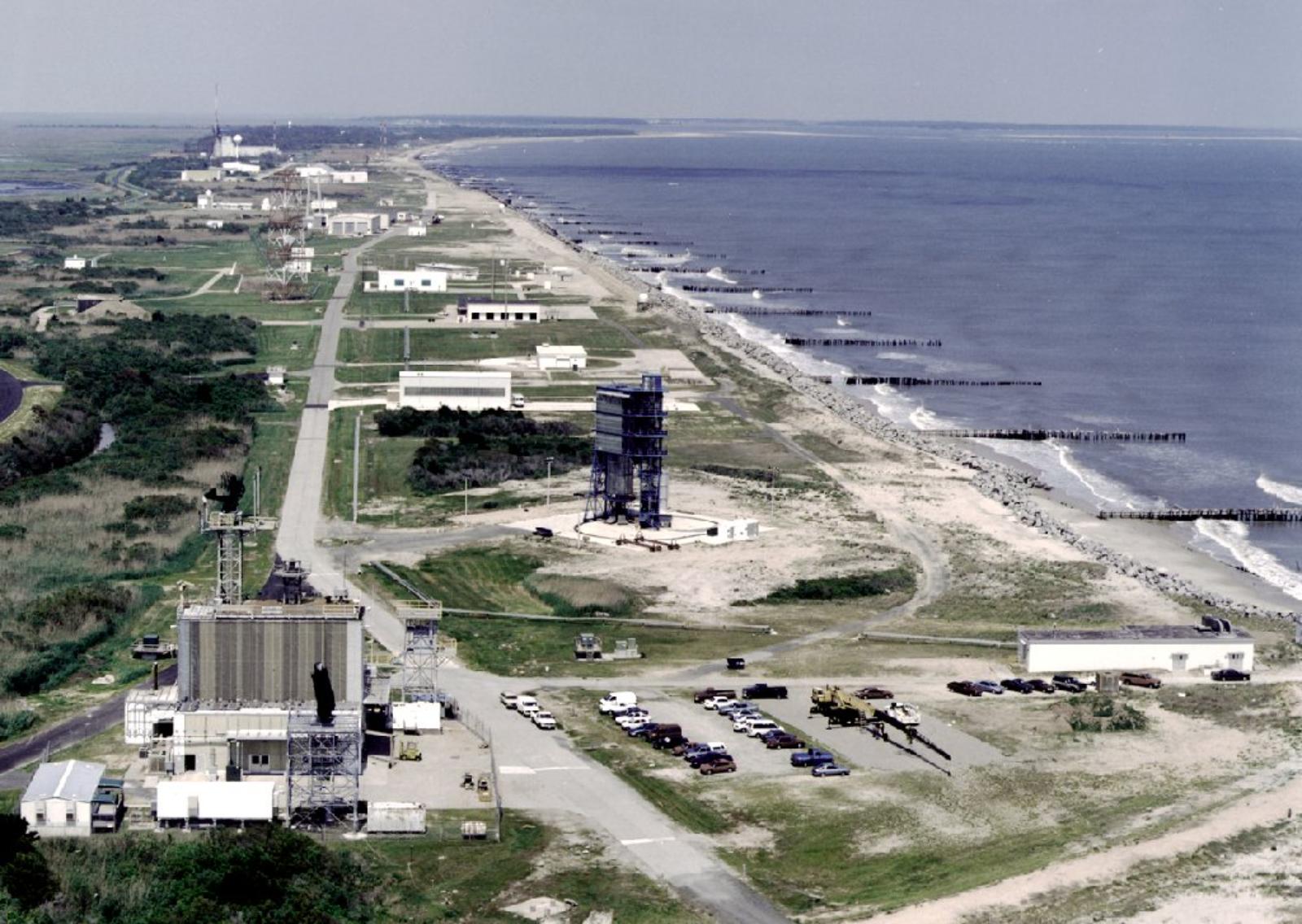
Located on Virginia’s Eastern Shore, Wallops Island is known for its NASA launch facility rather than residential appeal. It’s remote and surrounded by marshland and Atlantic coastline, which makes for beautiful views—but very few local services. There’s little in the way of shopping, dining, or senior-focused recreation.
The area has niche appeal for nature lovers and space enthusiasts, but retirees wanting walkable towns, community centers, or cultural life will be left wanting. It’s more of a workplace or a seasonal visit destination than a spot to put down retirement roots.
Wallops Island – ORS 13.13
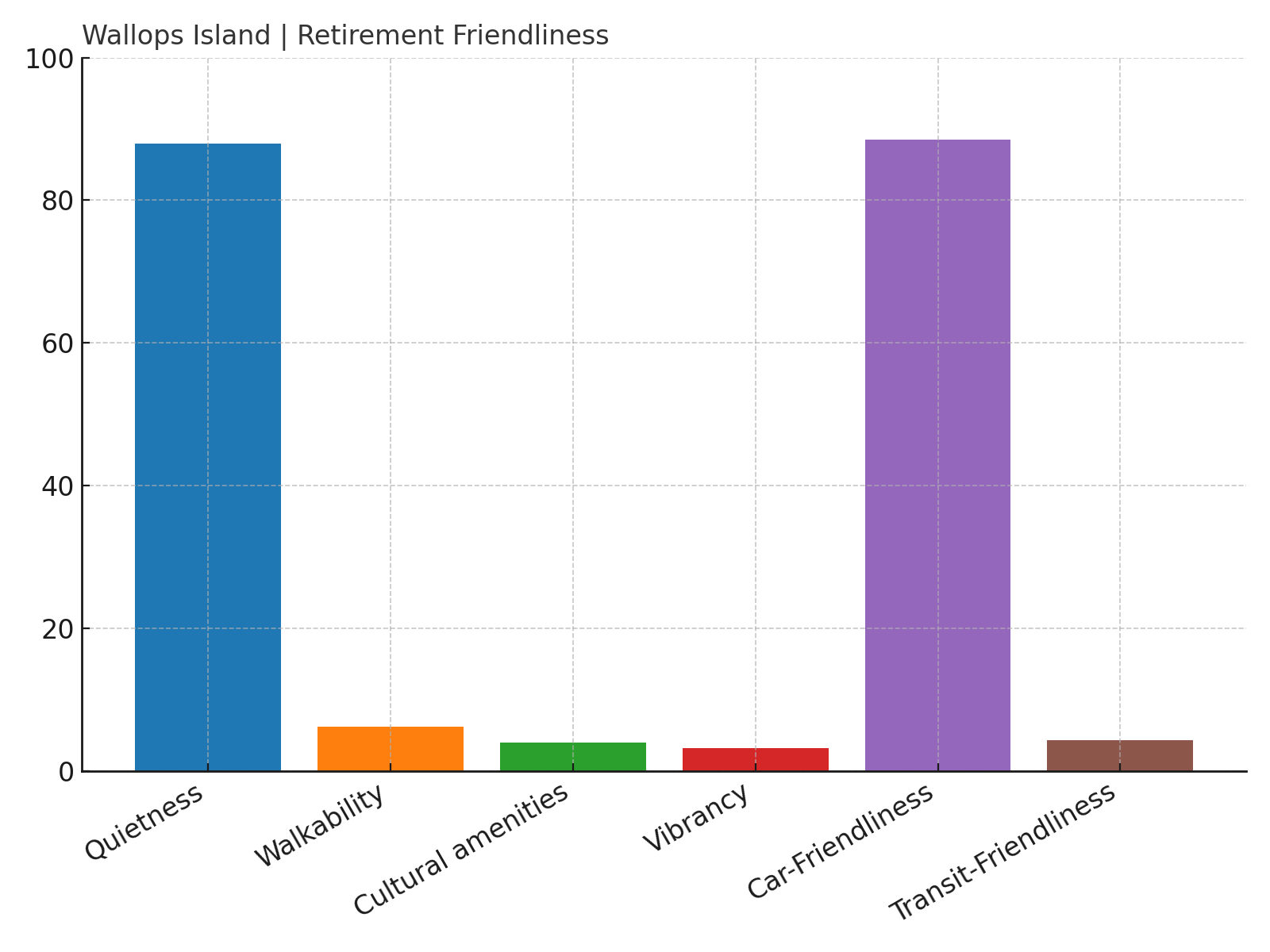
- Overall Retirement Score: 13.13
- Quietness: 87.92
- Walkability: 6.23
- Cultural amenities: 4.02
- Vibrancy: 3.14
- Car-Friendliness: 88.49
- Transit-Friendliness: 4.26
Despite the peace and natural beauty, Wallops Island scores an ORS of just 13.13. The isolation and lack of walkable features or cultural options make it difficult for retirees to feel connected or supported here.
15. Fort Belvoir – Military Operations Dominate Daily Life
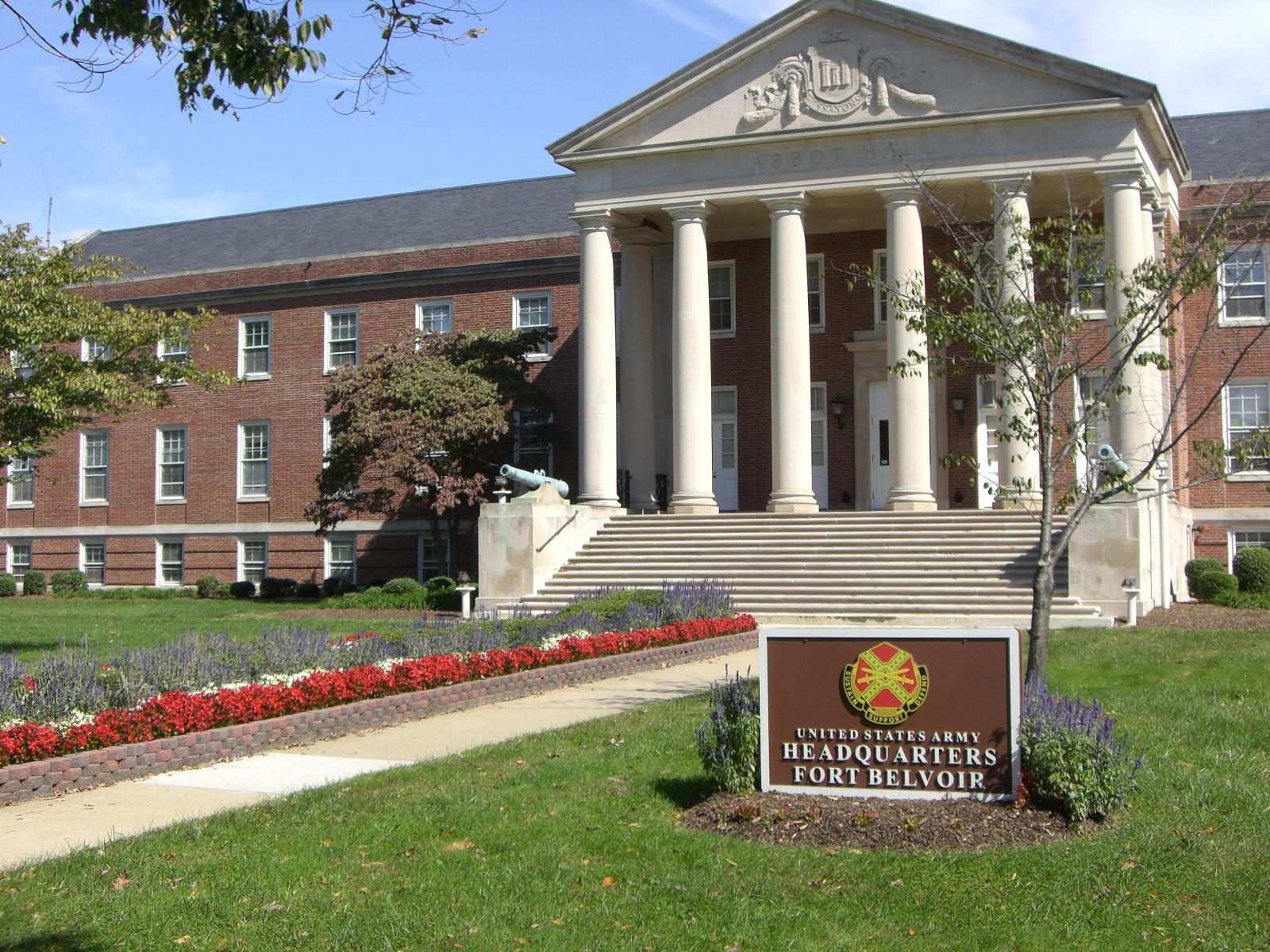
Fort Belvoir, located in Fairfax County, is a major military installation rather than a traditional town. That distinction matters. Civilian life revolves around base rules, and housing access is often limited. While the surrounding area is developed, it’s not especially retiree-friendly unless you have strong military ties.
Living here means dealing with security zones, traffic related to base activity, and a lack of senior-focused community spaces. It’s not a place designed with aging in mind, and retirees may find it lacking in the things that make daily life pleasant and fulfilling.
Fort Belvoir – ORS 11.28
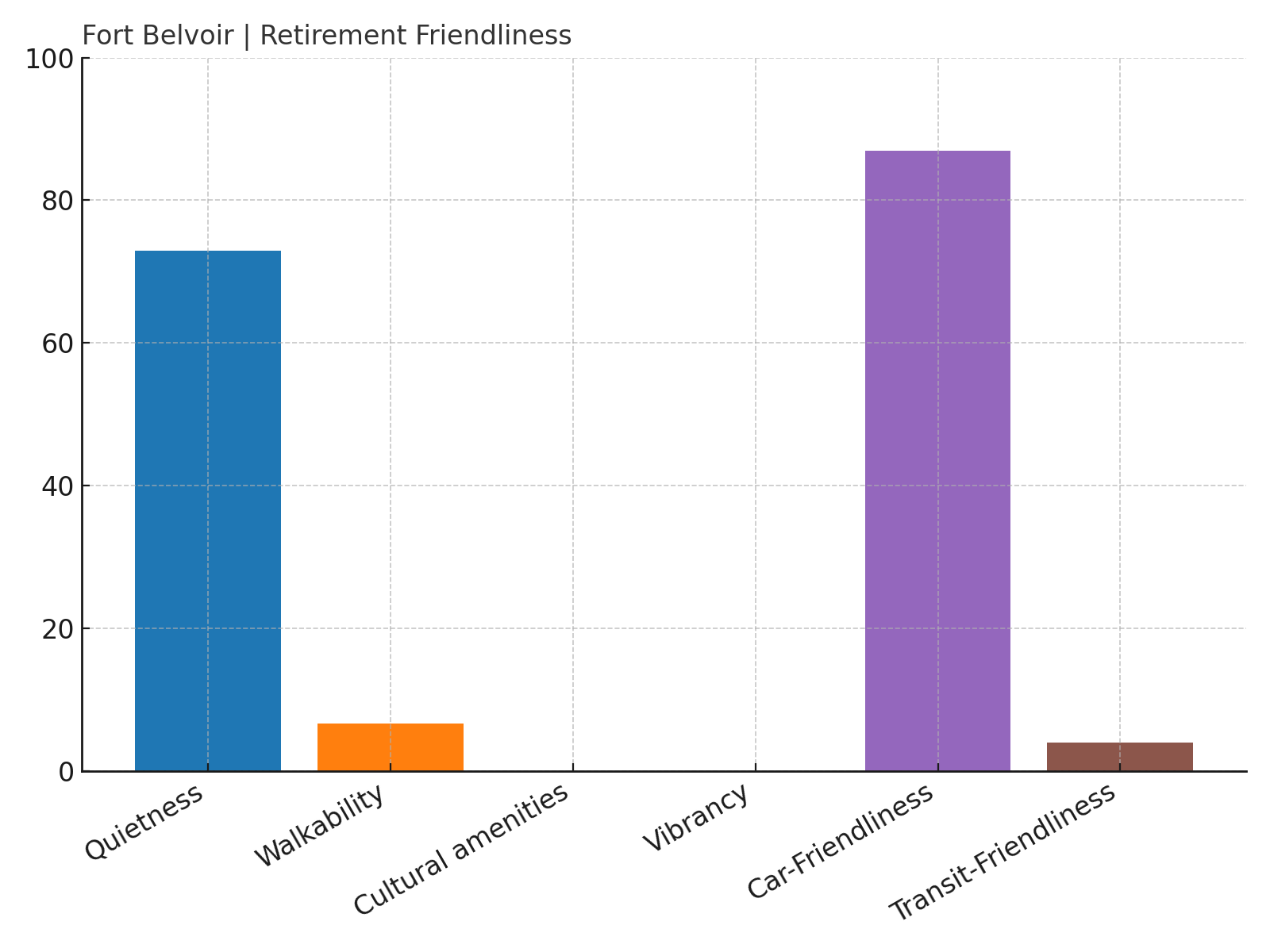
- Overall Retirement Score: 11.28
- Quietness: 72.89
- Walkability: 6.61
- Cultural amenities: 0.00
- Vibrancy: 0.00
- Car-Friendliness: 86.93
- Transit-Friendliness: 3.98
Fort Belvoir’s ORS of 11.28 speaks volumes. It scores zero for both cultural and vibrancy, making it an extremely limited option for those seeking a fulfilling retirement experience in Virginia.
14. Fort Lee – Lacking Civilian Infrastructure
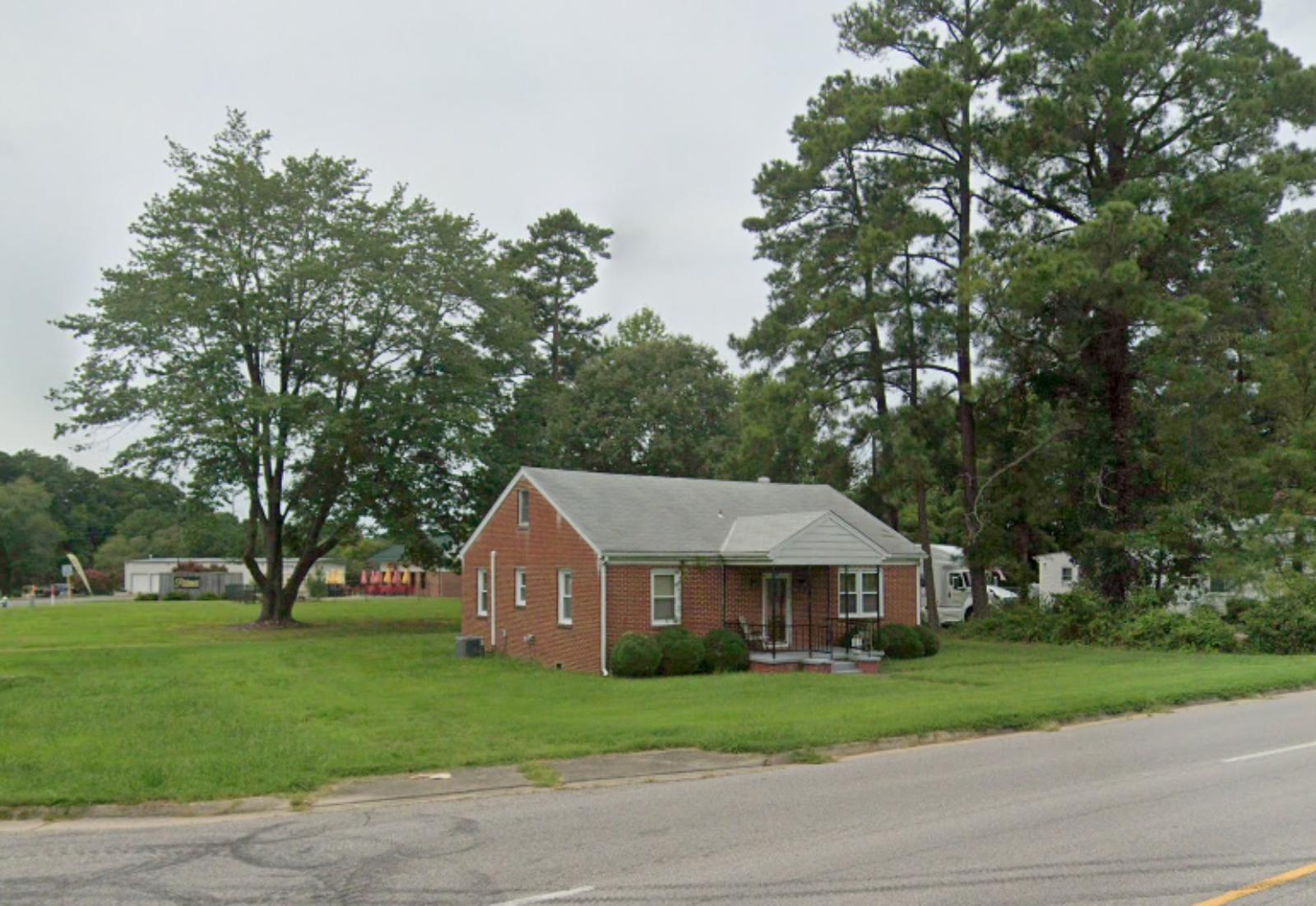
Fort Lee, situated in the Tri-Cities area near Petersburg, is another active military base with limited appeal for retirees. Much of the available housing and services are for active-duty personnel and their families, which leaves very little aimed at older adults. That includes healthcare, transportation, and community engagement opportunities.
The base location means most amenities require a drive into nearby towns, and public transit is nearly nonexistent. For civilians—especially retirees—it can feel both physically and socially cut off from the outside world.
Fort Lee – ORS 6.48
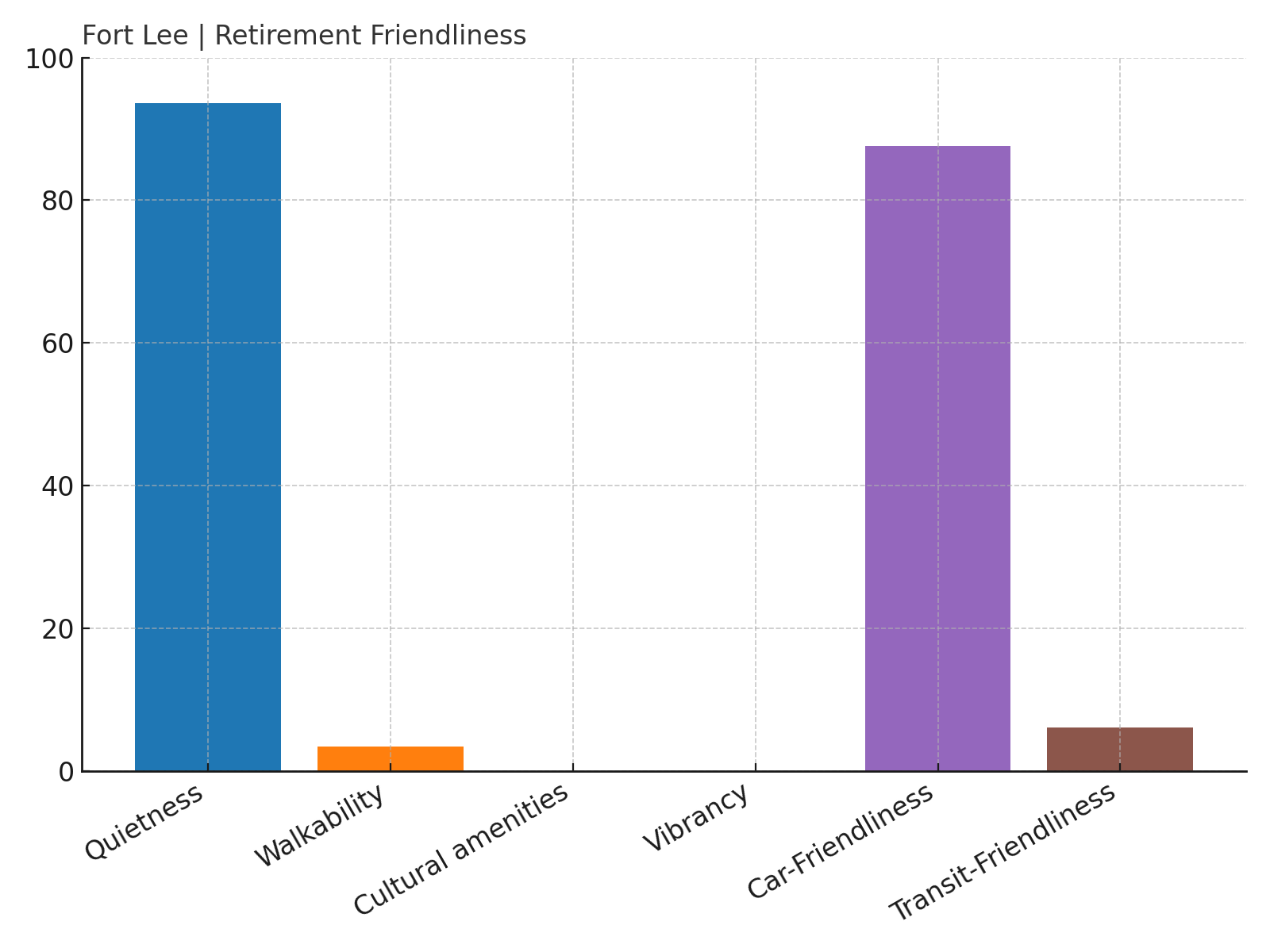
- Overall Retirement Score: 6.48
- Quietness: 93.58
- Walkability: 3.38
- Cultural amenities: 0.00
- Vibrancy: 0.00
- Car-Friendliness: 87.57
- Transit-Friendliness: 6.03
With a rock-bottom ORS of 6.48, Fort Lee is the least retiree-friendly place in this batch. Despite being quiet, the complete absence of culture, walkability, and vibrancy makes it a poor choice for civilian retirement living.
13. Franklin – Quiet, But Missing the Essentials
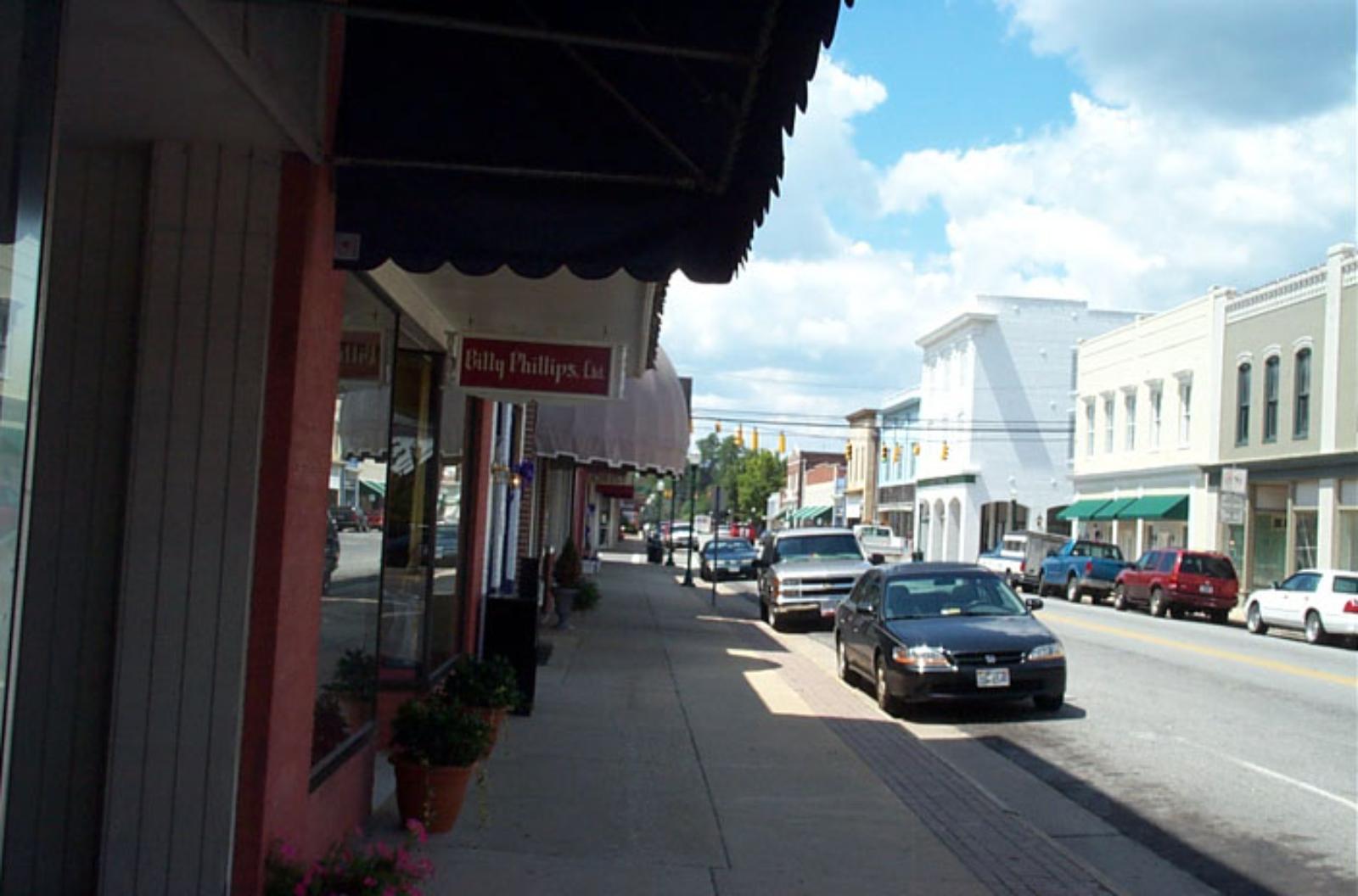
Franklin is an independent city tucked in southeastern Virginia, near the North Carolina border. Historically a mill town, it retains a calm, small-town feel that appeals to some—but for retirees, it’s not quite enough. While the quietness score is decent, the town’s lack of medical facilities, limited shopping, and few community spaces can be a drawback for older adults.
It’s a place where driving is a necessity and where opportunities for enrichment and engagement are slim. Franklin may work well for self-sufficient couples or those with strong ties to the area, but anyone looking for an active or connected retirement lifestyle might find it lacking.
Franklin – ORS 22.79
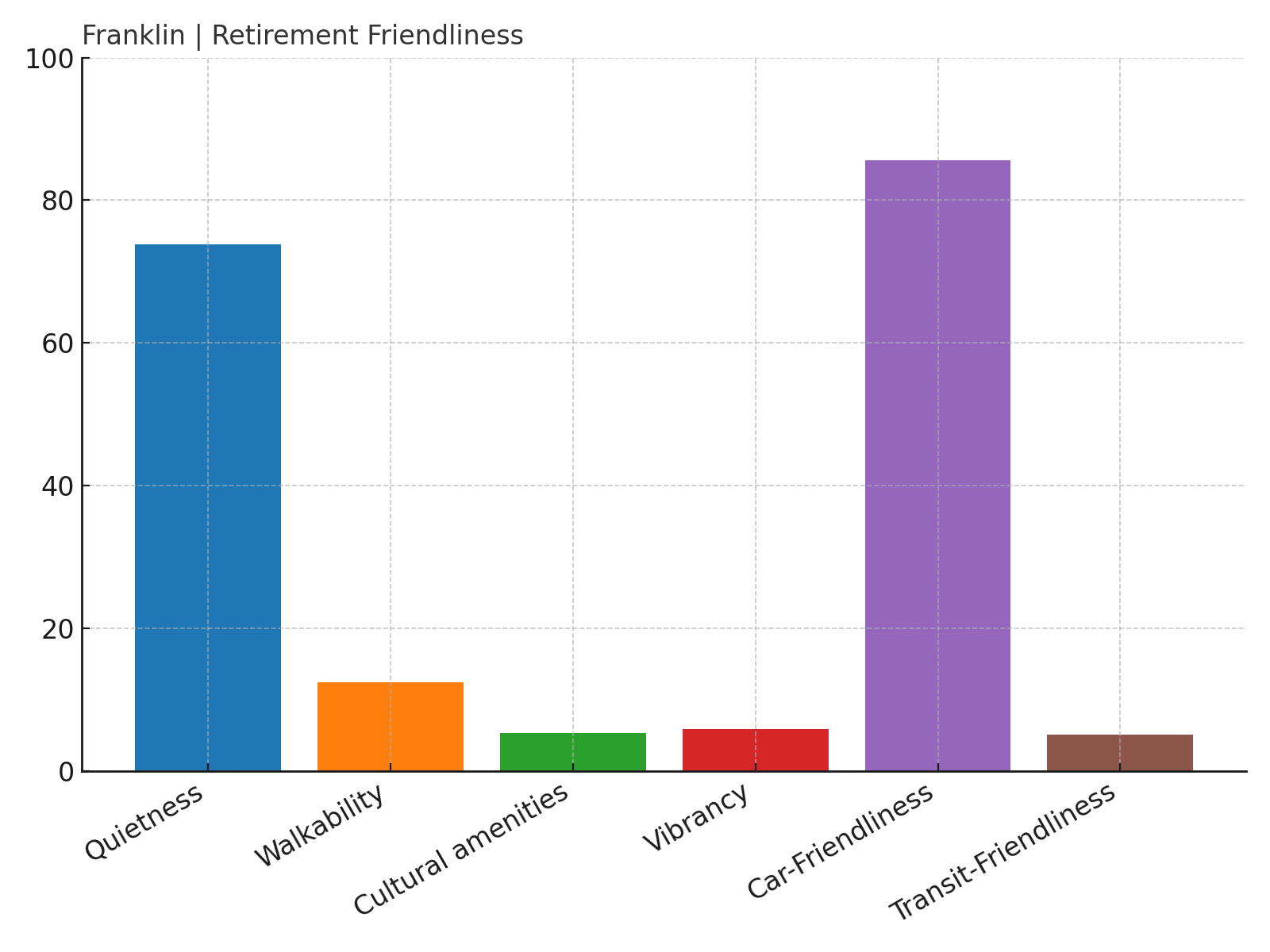
- Overall Retirement Score: 22.79
- Quietness: 73.86
- Walkability: 12.39
- Cultural amenities: 5.34
- Vibrancy: 5.82
- Car-Friendliness: 85.62
- Transit-Friendliness: 5.07
With an ORS of 22.79, Franklin offers a peaceful setting, but it falls short on services that retirees often rely on. A car is essential here, and the limited vibrancy keeps it lower on the list for older adults seeking more connection and activity.
12. Bowling Green – Sleepy and Car-Dependent
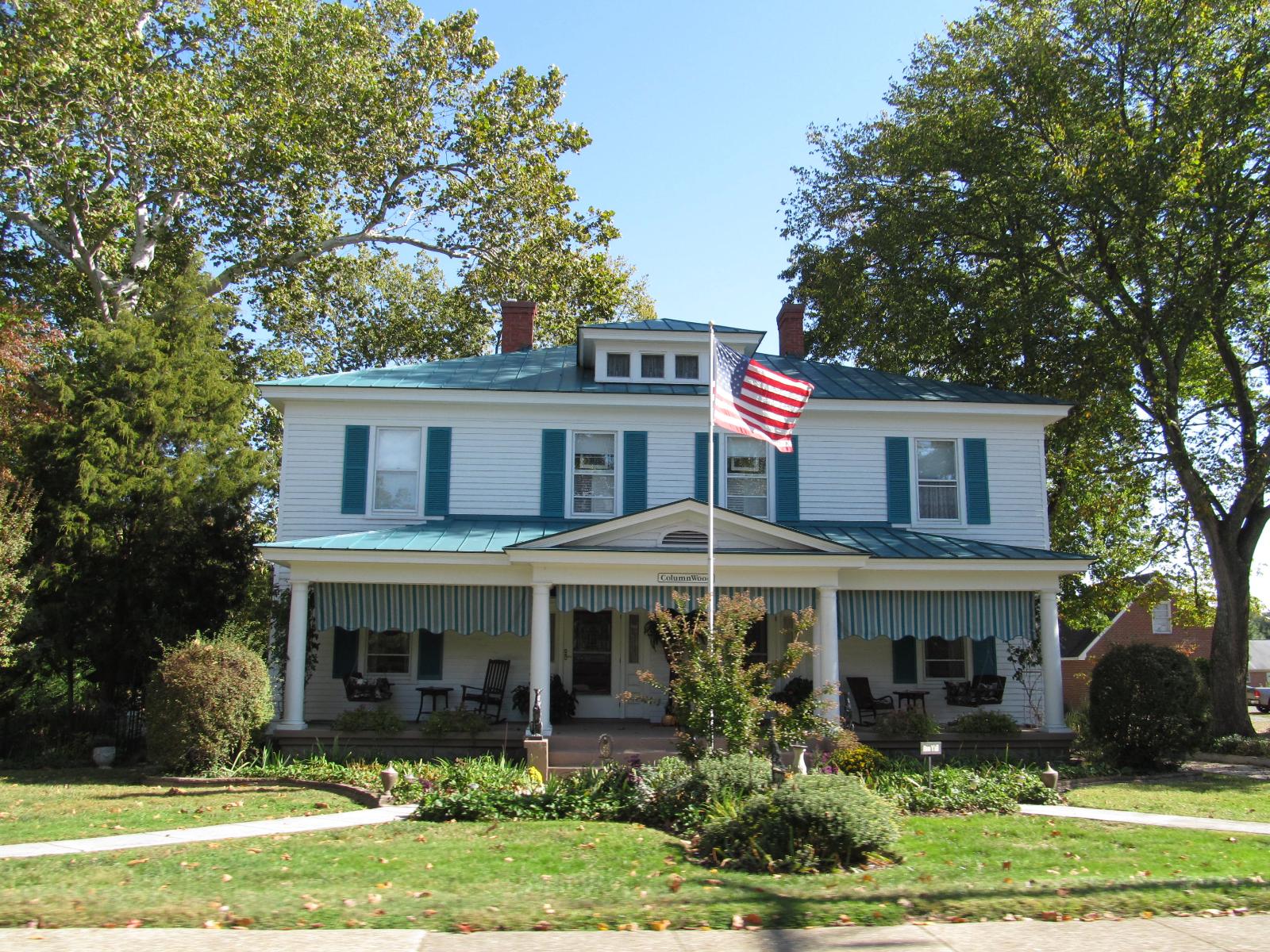
Located between Richmond and Fredericksburg, Bowling Green is a small town that’s more about quiet streets than bustling activity. It has a quaint main street, but beyond that, the options are limited. Retirees may enjoy the low-key vibe, but a lack of cultural options, walkable areas, and senior services could pose challenges over time.
The nearest major services are a drive away, and transit options are minimal. For retirees who don’t want to rely on a car for everything, or who are looking for more stimulation, Bowling Green might feel too limited in scope and opportunity.
Bowling Green – ORS 25.11
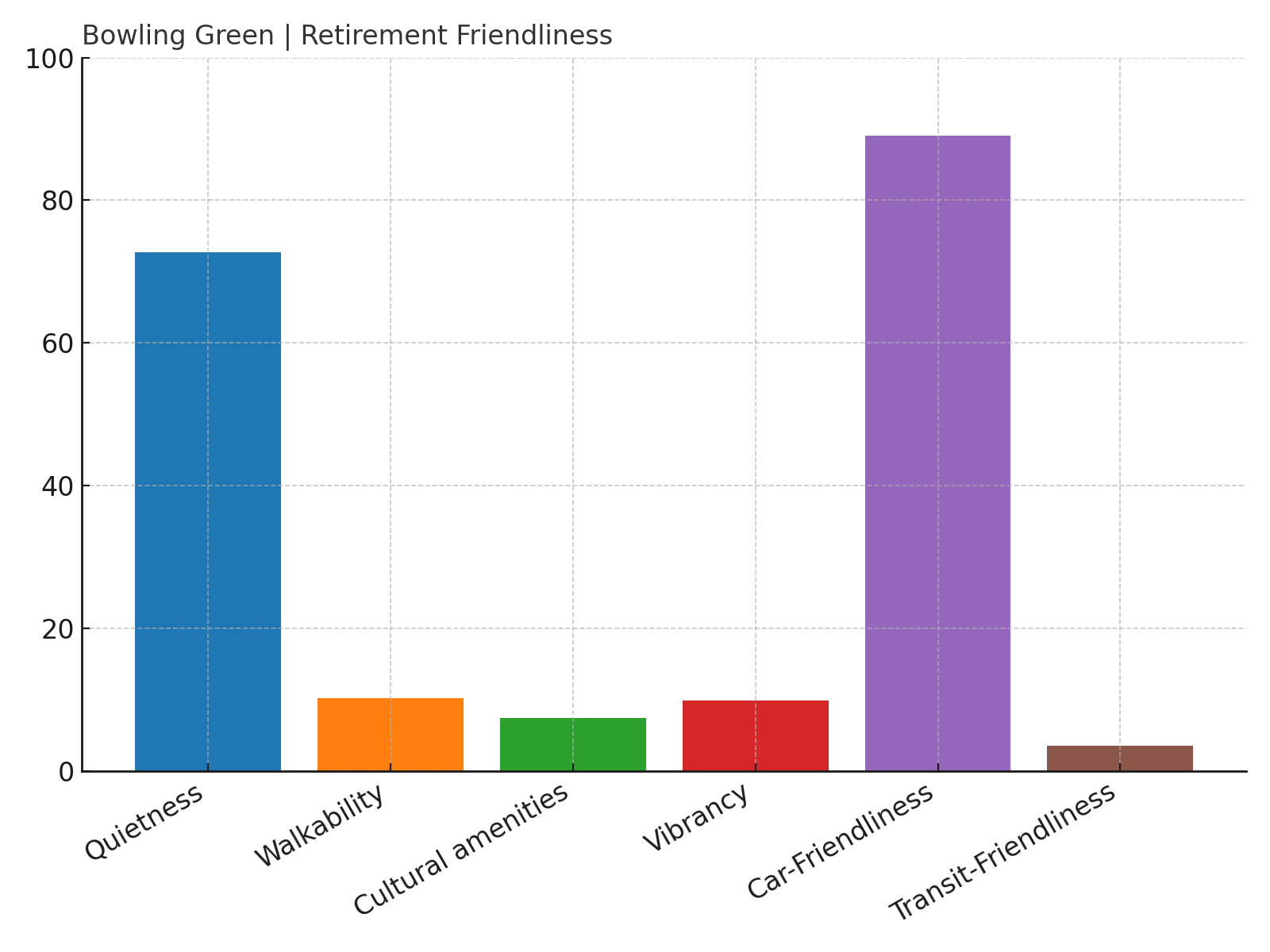
- Overall Retirement Score: 25.11
- Quietness: 72.75
- Walkability: 10.25
- Cultural amenities: 7.38
- Vibrancy: 9.89
- Car-Friendliness: 89.10
- Transit-Friendliness: 3.55
Bowling Green’s ORS of 25.11 suggests that while it’s relatively pleasant, the town’s reliance on cars and modest cultural offerings make it a middling choice for retirees who want more than just peace and quiet.
11. Chase City – Limited Resources for Seniors
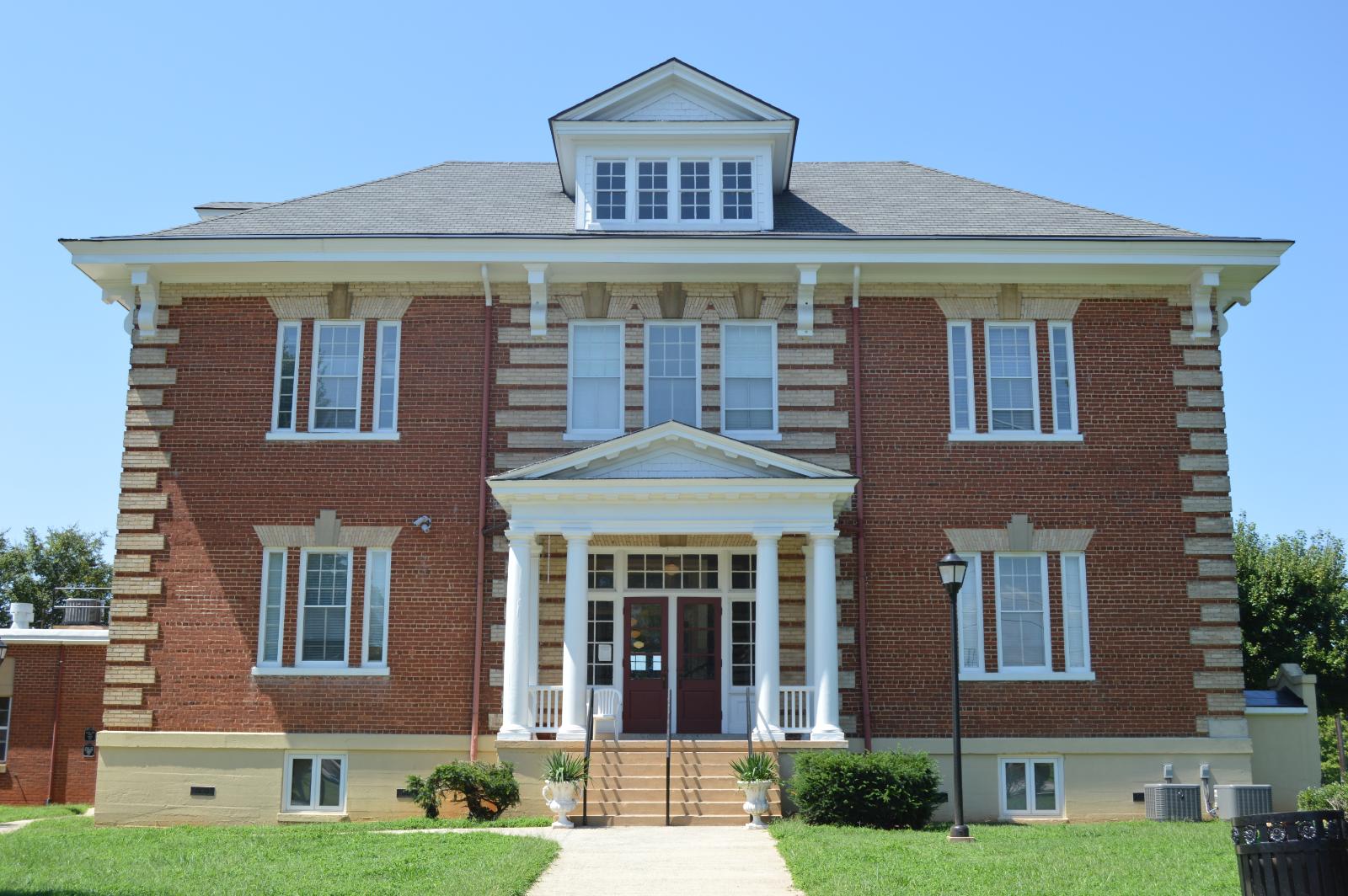
Chase City is a small town in south-central Virginia, known for its rural character and tight-knit feel. While that may appeal to some, the town has limited infrastructure to support aging residents. It lacks diverse dining, cultural centers, or senior-focused programs that many retirees consider essential to quality of life.
The area is fairly car-friendly, but transit options are minimal. Walkability is improving but still low, and access to major healthcare services typically requires a trip to nearby towns. Retirees who prioritize independence and amenities may find Chase City too sparse.
Chase City – ORS 26.02
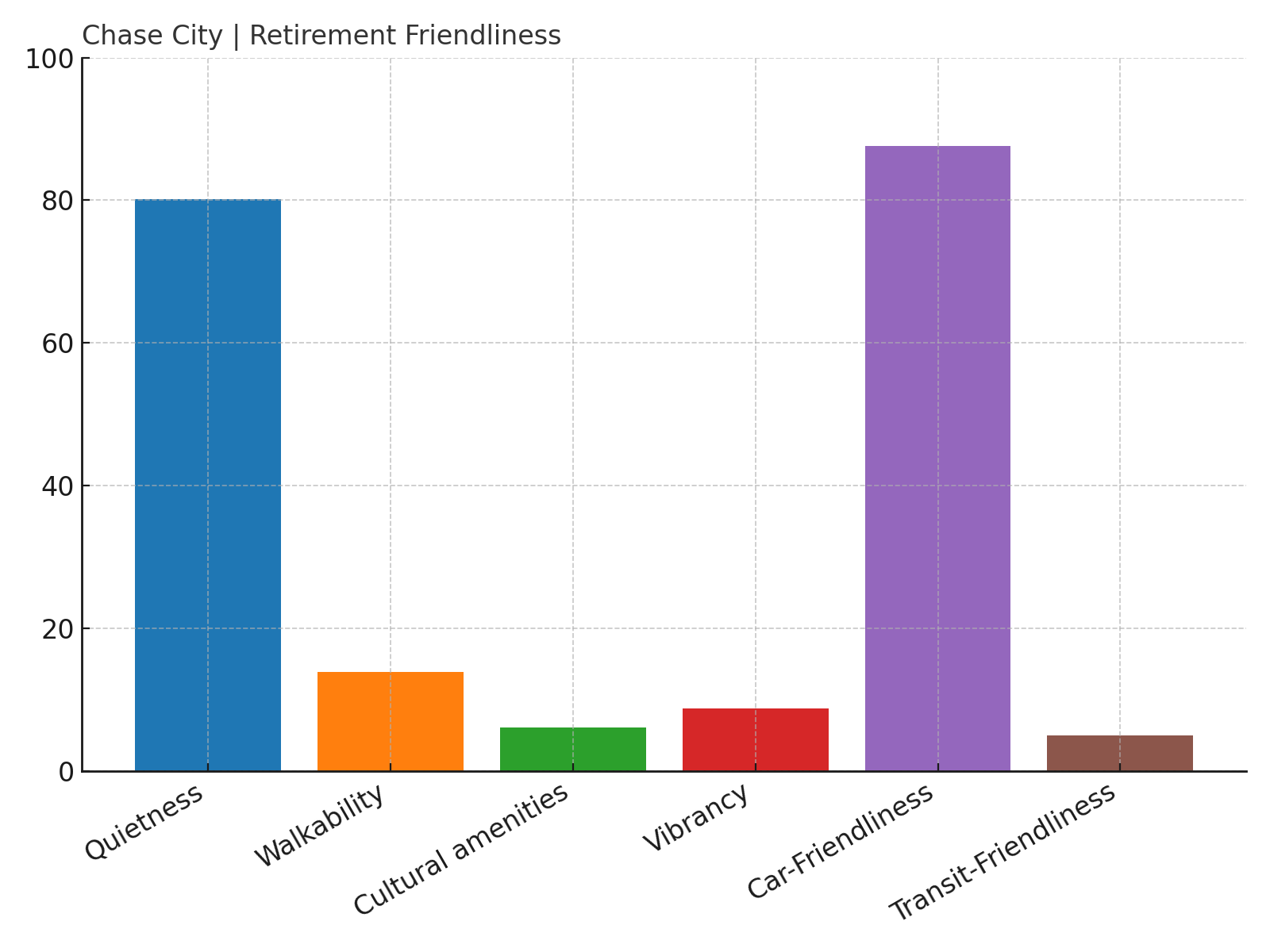
- Overall Retirement Score: 26.02
- Quietness: 80.14
- Walkability: 13.84
- Cultural amenities: 6.12
- Vibrancy: 8.77
- Car-Friendliness: 87.65
- Transit-Friendliness: 4.92
Chase City’s ORS of 26.02 reflects a decent level of quiet and basic amenities, but it still struggles to meet the broader needs of today’s retirees. While not the worst, it lags behind towns that offer more robust support for aging adults.
10. Emporia – Flat Experience in a Quiet Setting
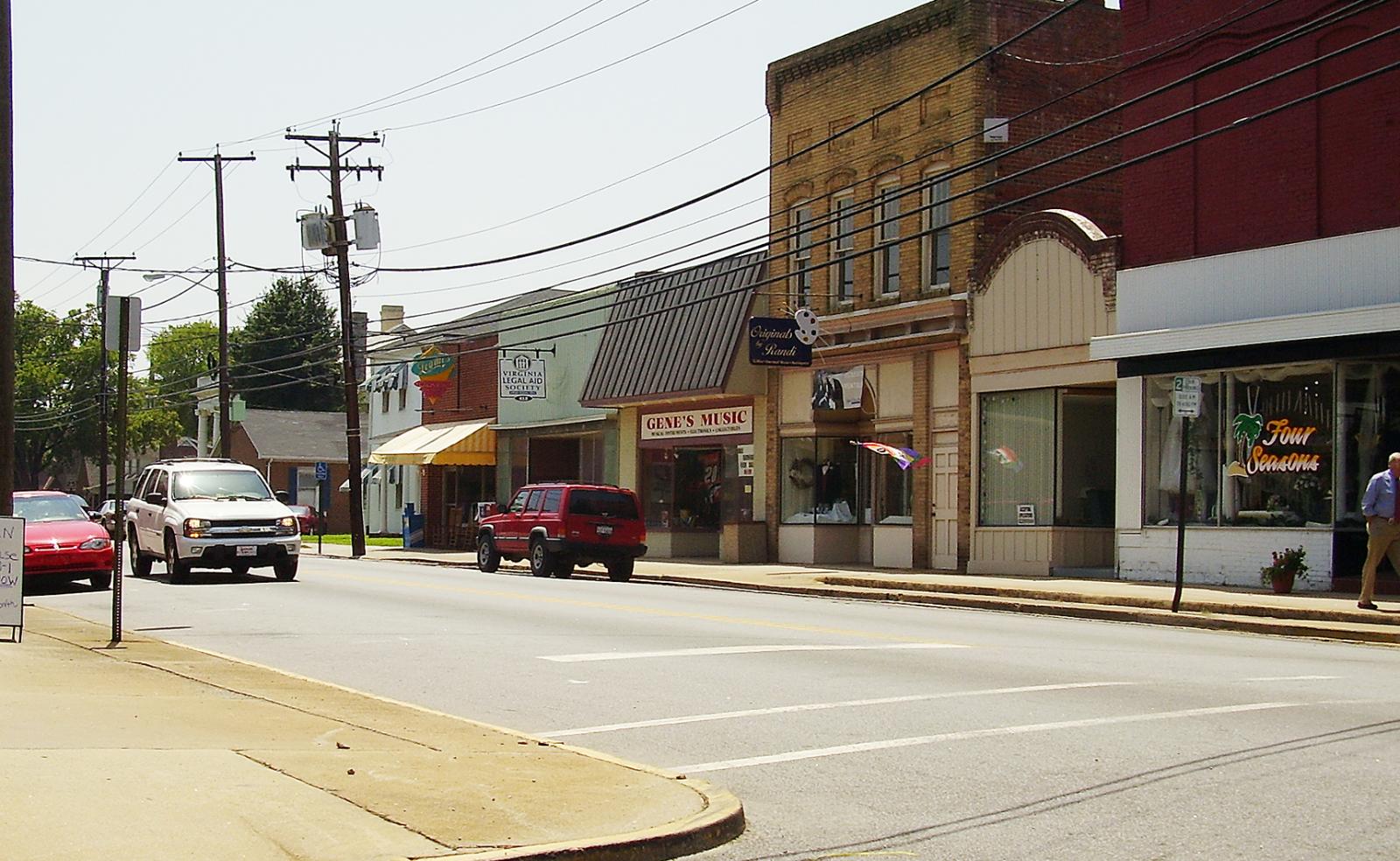
Emporia lies along I-95 near the North Carolina border and serves primarily as a rest stop and transportation hub. While that makes it convenient for travel, it doesn’t offer much for retirees hoping for a rich day-to-day life. Entertainment, culture, and walkable destinations are limited, and its compact downtown isn’t built with older residents in mind.
The town’s economy revolves around logistics and highway services, not senior living. As such, it lacks the charm or tailored features that retirees often seek when relocating or downsizing.
Emporia – ORS 26.25
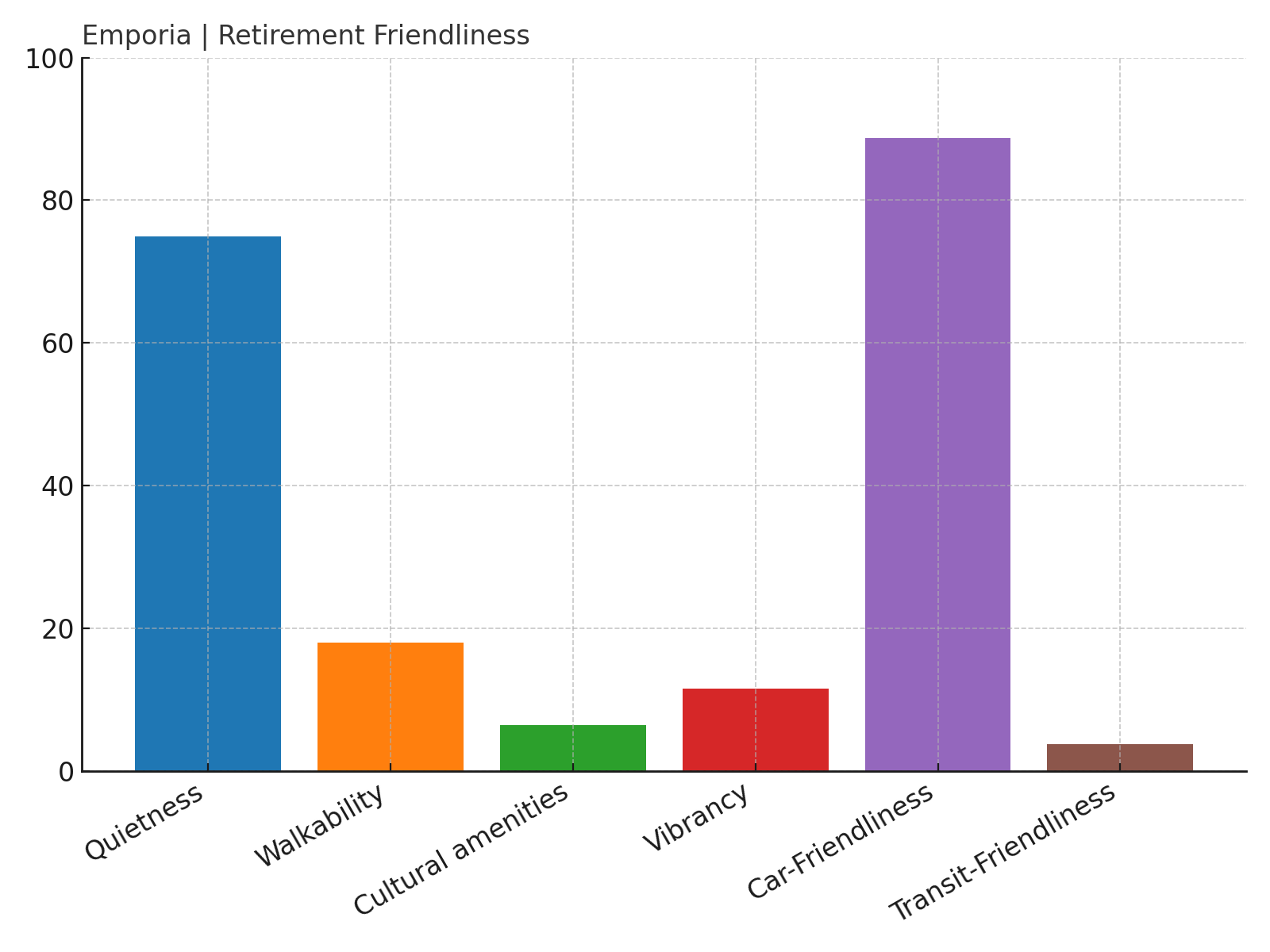
- Overall Retirement Score: 26.25
- Quietness: 74.91
- Walkability: 18.02
- Cultural amenities: 6.37
- Vibrancy: 11.48
- Car-Friendliness: 88.70
- Transit-Friendliness: 3.75
Emporia earns a modest ORS of 26.25. While it’s peaceful and drivable, retirees may find the overall experience a bit underwhelming, especially if they’re hoping for more engagement or cultural interest in their retirement years.
9. Blackstone – Some Perks, But Still Lacking
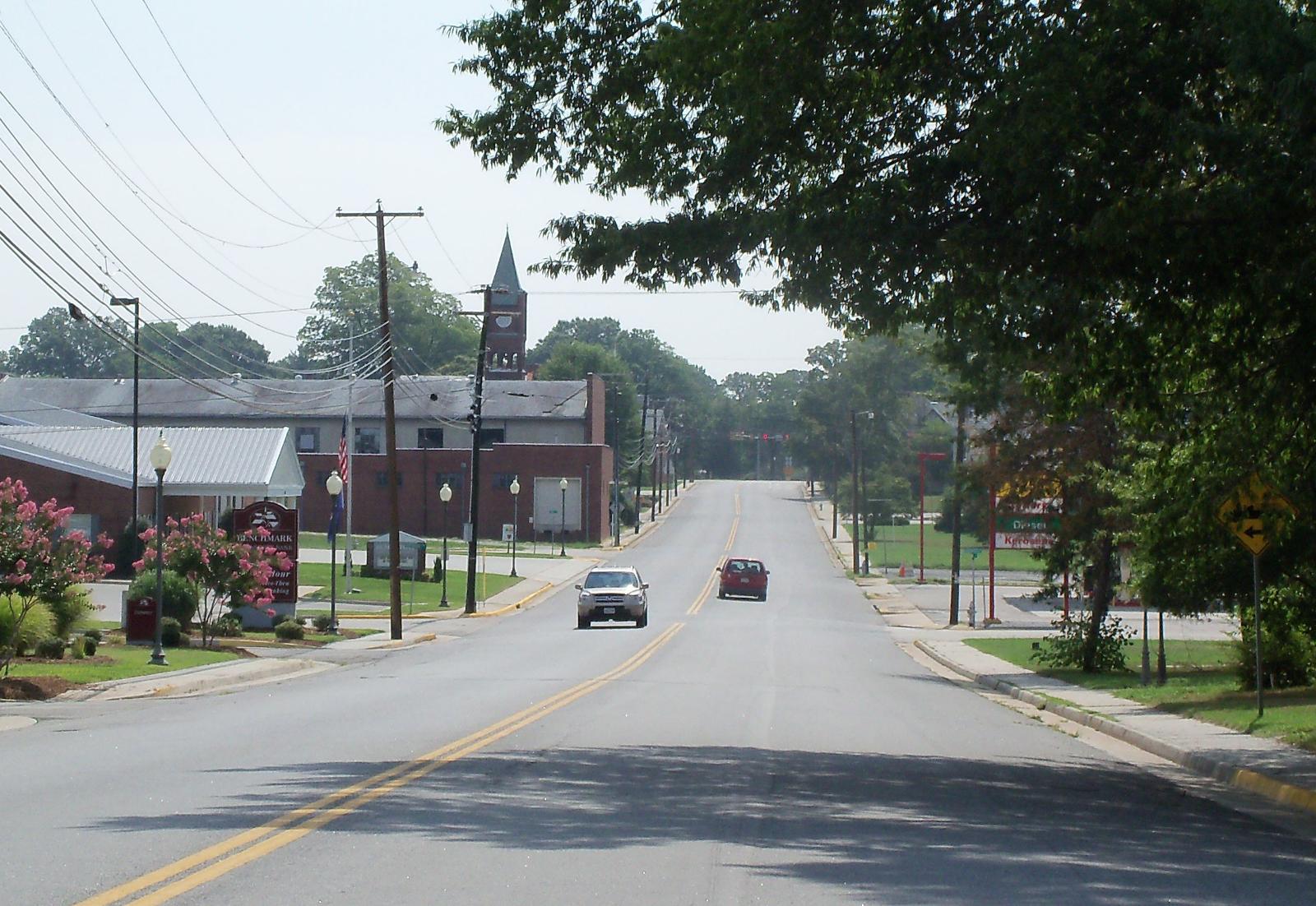
Blackstone, located in south-central Virginia, has a bit more going on than some towns on this list. It features historic architecture and a small but active community. However, retirees still face challenges here, including limited healthcare options, few dedicated senior resources, and a fairly low walkability score.
It’s more suited to younger families or remote workers seeking a quiet lifestyle. For retirees who want access to arts, social opportunities, and senior-friendly infrastructure, Blackstone falls short in key areas.
Blackstone – ORS 28.00
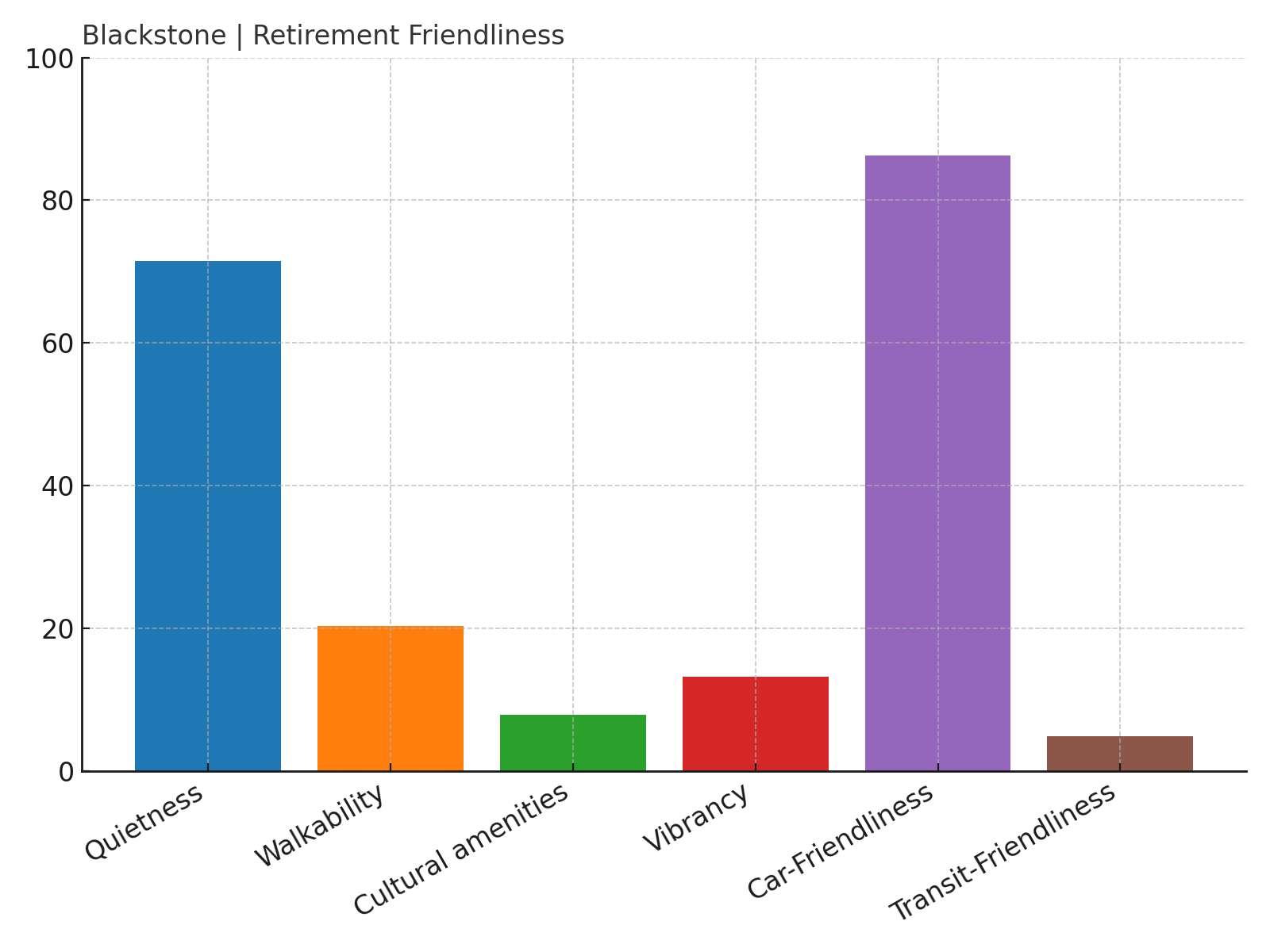
- Overall Retirement Score: 28.00
- Quietness: 71.53
- Walkability: 20.34
- Cultural amenities: 7.81
- Vibrancy: 13.22
- Car-Friendliness: 86.32
- Transit-Friendliness: 4.84
With an ORS of 28.00, Blackstone is on the higher end of this list but still falls behind more robust retirement towns. It offers a little more activity, but not enough to fully support a fulfilling senior lifestyle.
8. Bedford – Picturesque but Not Practical
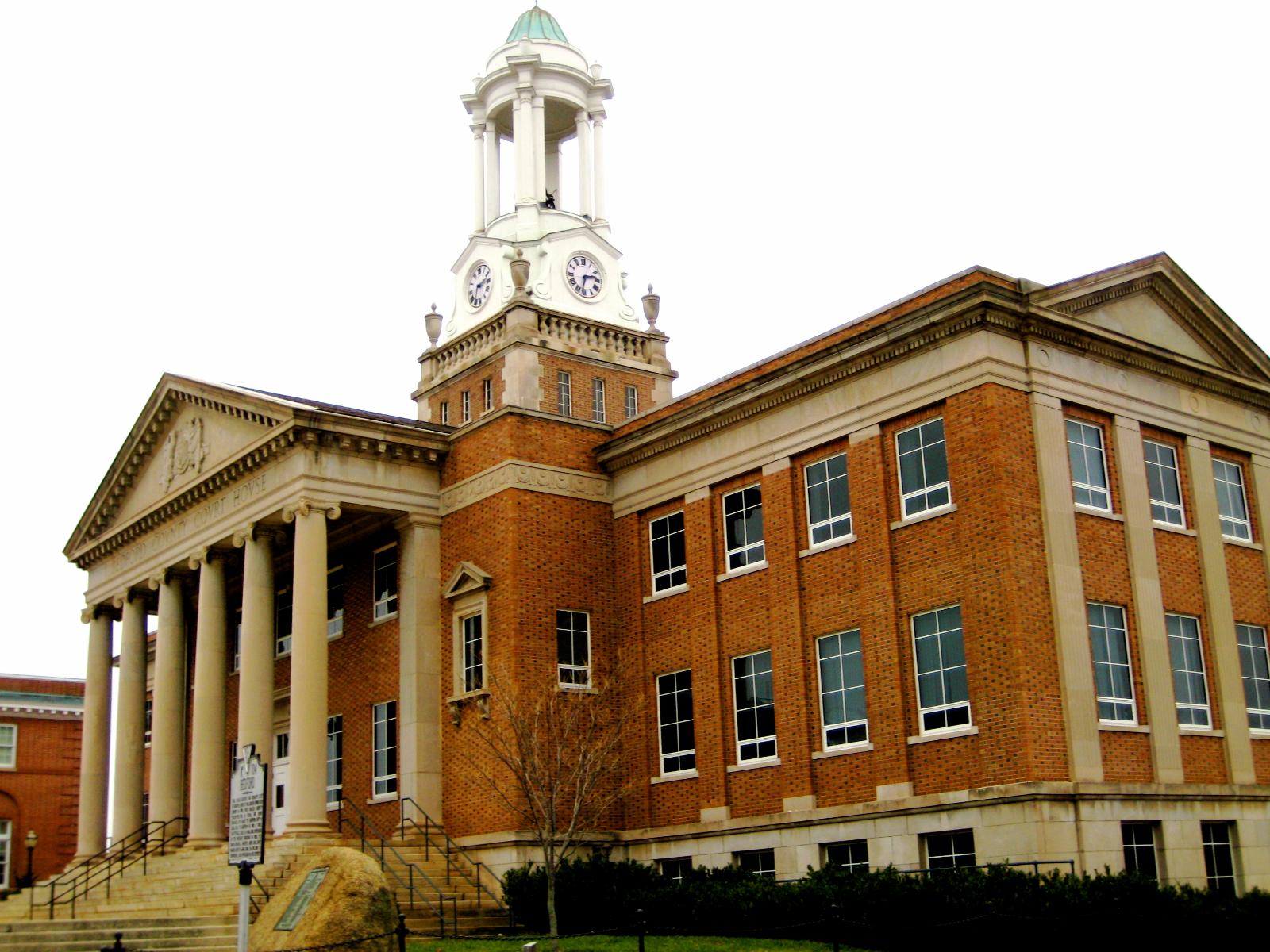
Bedford sits in central Virginia, nestled between Lynchburg and Roanoke, and is known for its beautiful views of the Blue Ridge Mountains. It has historical charm and a close-knit feel, but when it comes to retirement needs, it leaves a lot on the table. Despite moderate cultural offerings, the town’s infrastructure doesn’t fully support older adults looking for walkable spaces, robust healthcare access, or senior-friendly services.
It’s a lovely town for weekend getaways or seasonal visits, but long-term living may be more difficult without strong community support or accessible public transit. Retirees who want convenience and daily engagement may find Bedford scenic—but a little inconvenient.
Bedford – ORS 28.17
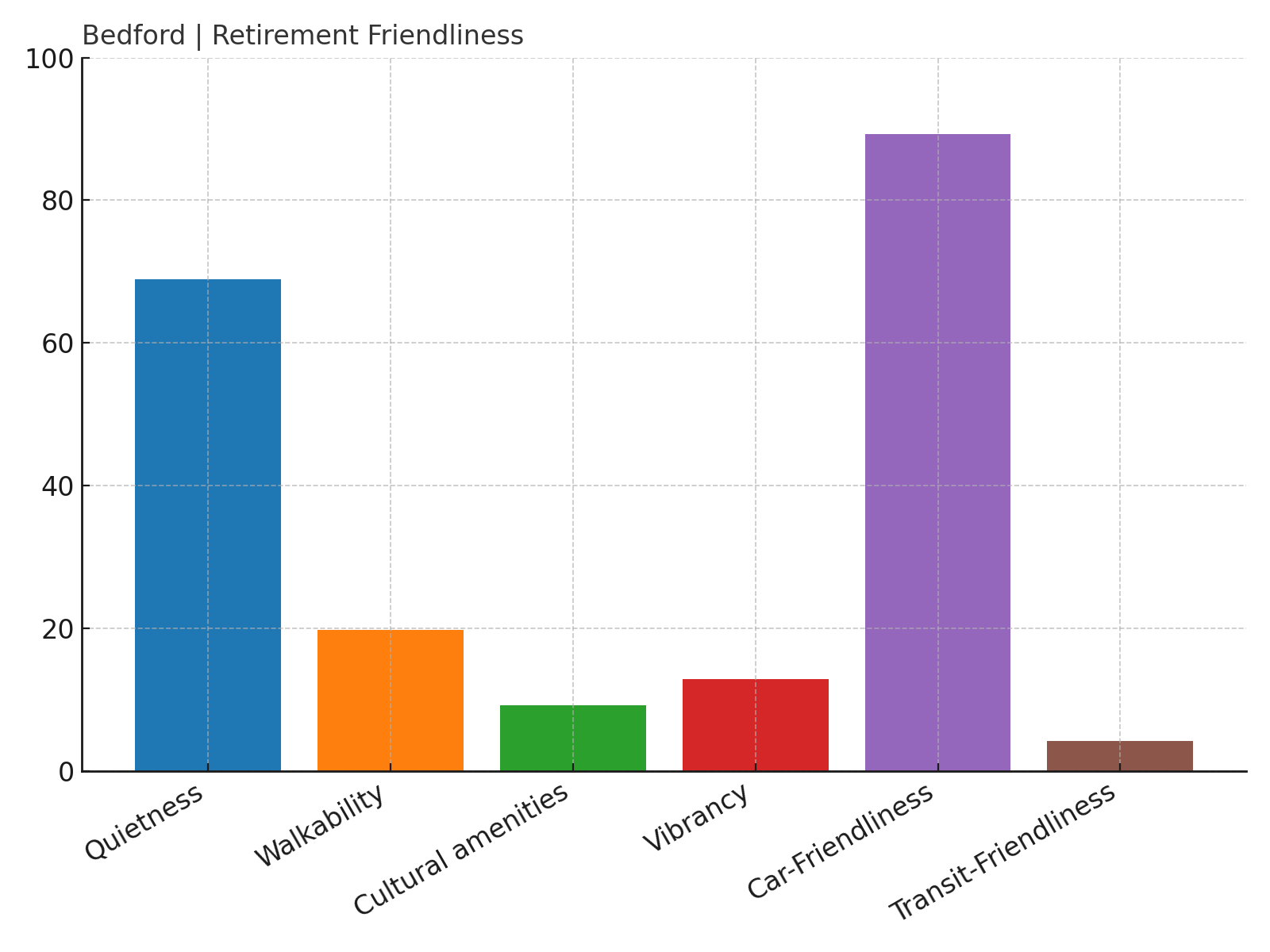
- Overall Retirement Score: 28.17
- Quietness: 68.91
- Walkability: 19.76
- Cultural amenities: 9.21
- Vibrancy: 12.90
- Car-Friendliness: 89.24
- Transit-Friendliness: 4.15
Bedford’s ORS of 28.17 reflects its balance of charm and shortcomings. While the setting is lovely and the vibe is calm, retirees who need convenience and access may feel the town just doesn’t go far enough.
7. South Boston – Active But A Bit Unbalanced
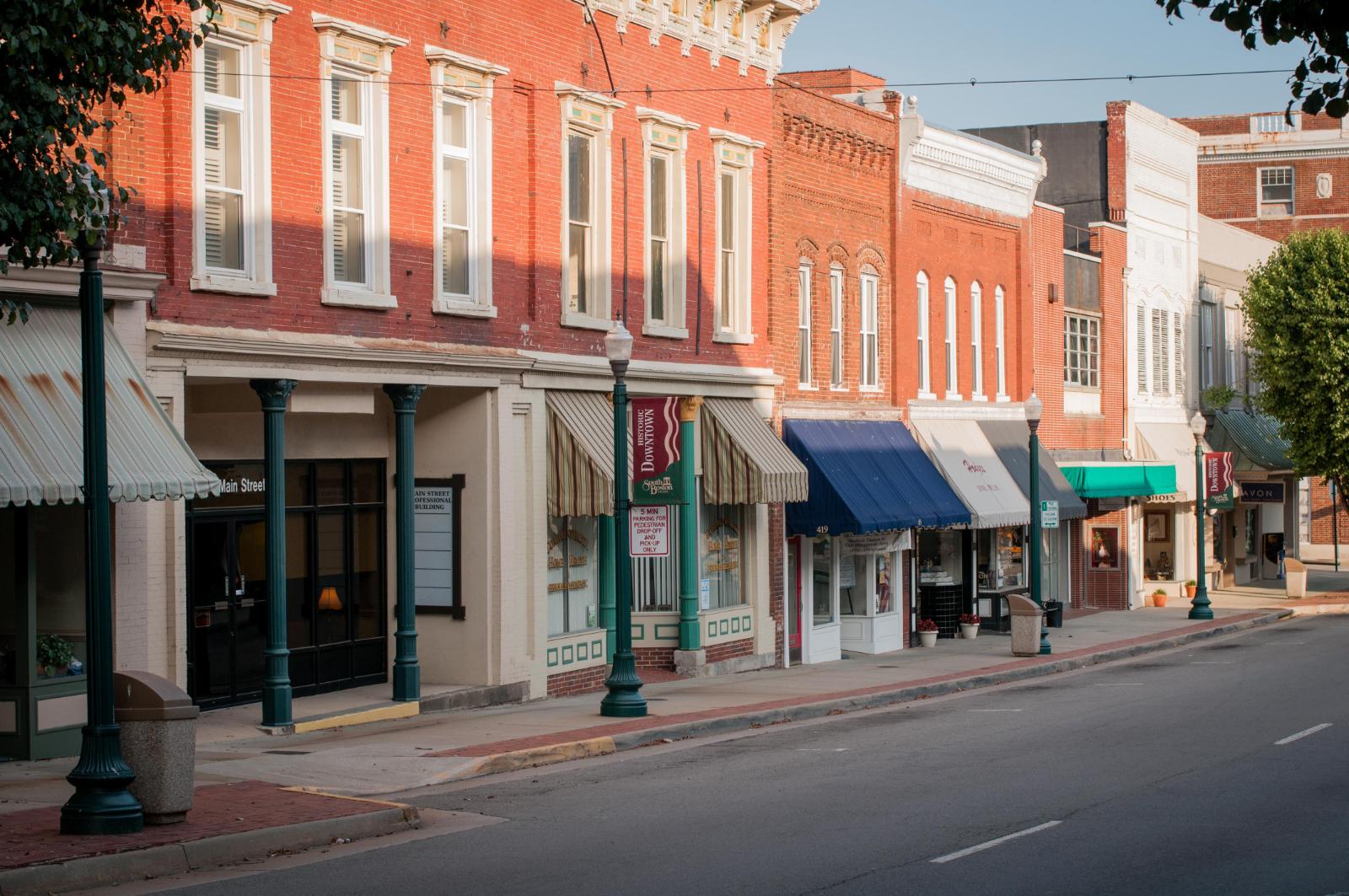
South Boston in southern Virginia offers more energy than many towns on this list. It has historical landmarks, a community arts scene, and several small festivals throughout the year. However, retirees may still find it a mixed bag. There’s a noticeable lack of strong transit and senior-specific services, and many amenities remain car-oriented rather than pedestrian-friendly.
The town works for retirees who can stay active and independent, but for those hoping to age in place with ease, the lack of convenience features could become frustrating. It may suit younger retirees better than those with mobility needs.
South Boston – ORS 28.22
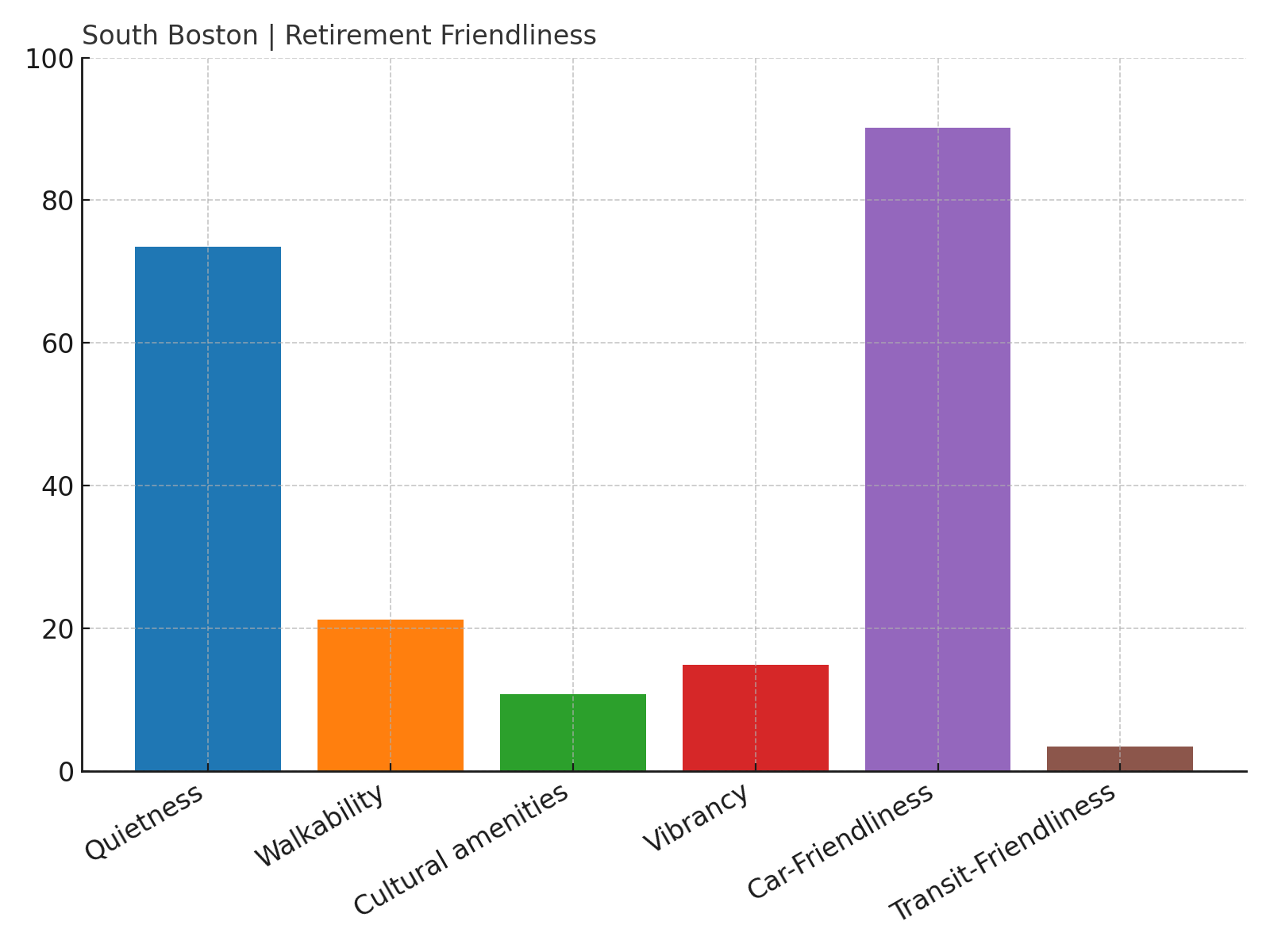
- Overall Retirement Score: 28.22
- Quietness: 73.49
- Walkability: 21.18
- Cultural amenities: 10.76
- Vibrancy: 14.87
- Car-Friendliness: 90.17
- Transit-Friendliness: 3.44
With a decent ORS of 28.22, South Boston ranks better than most on this list—but it’s still not quite there for retirement living. Cultural life is a plus, but transit gaps and lack of dedicated senior services hold it back.
6. Crewe – Small Town, Sparse Services
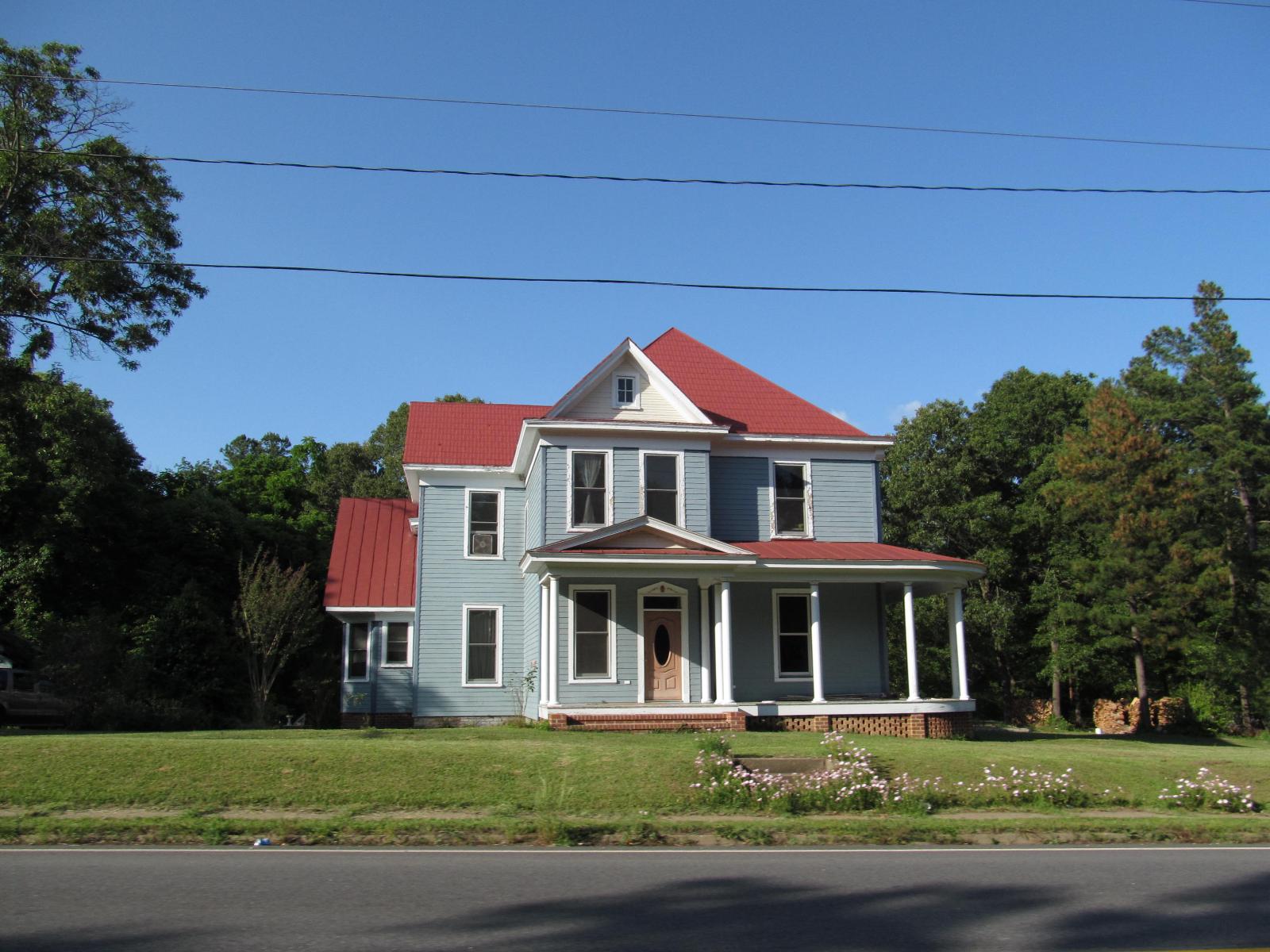
Crewe is a tiny town in south-central Virginia known for its rail history and slower pace of life. While quiet and safe, it lacks the amenities and services retirees typically rely on. Medical facilities are limited, social spaces are few, and the town doesn’t offer much beyond the basics for day-to-day living.
Crewe may appeal to those seeking a completely laid-back retirement in a tight-knit rural setting, but for retirees who want variety, stimulation, or easy access to care, it could feel overly quiet—and possibly isolating.
Crewe – ORS 28.31
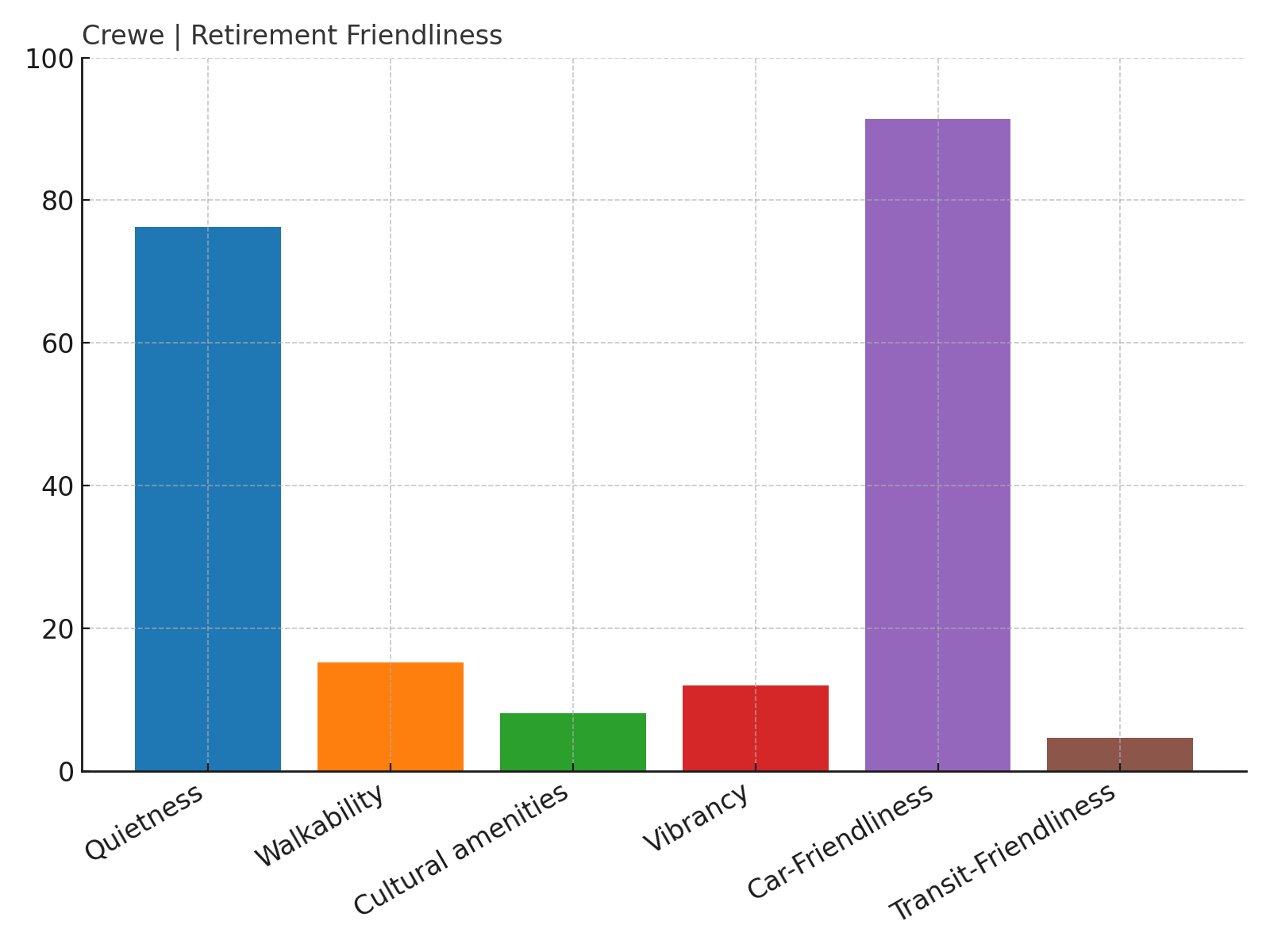
- Overall Retirement Score: 28.31
- Quietness: 76.25
- Walkability: 15.17
- Cultural amenities: 8.09
- Vibrancy: 12.02
- Car-Friendliness: 91.38
- Transit-Friendliness: 4.59
Crewe’s ORS of 28.31 puts it on the bubble—quiet and somewhat charming, but not well-equipped for retirees who want access, support, and more than just peace and quiet.
5. Galax – Good Music, Few Services
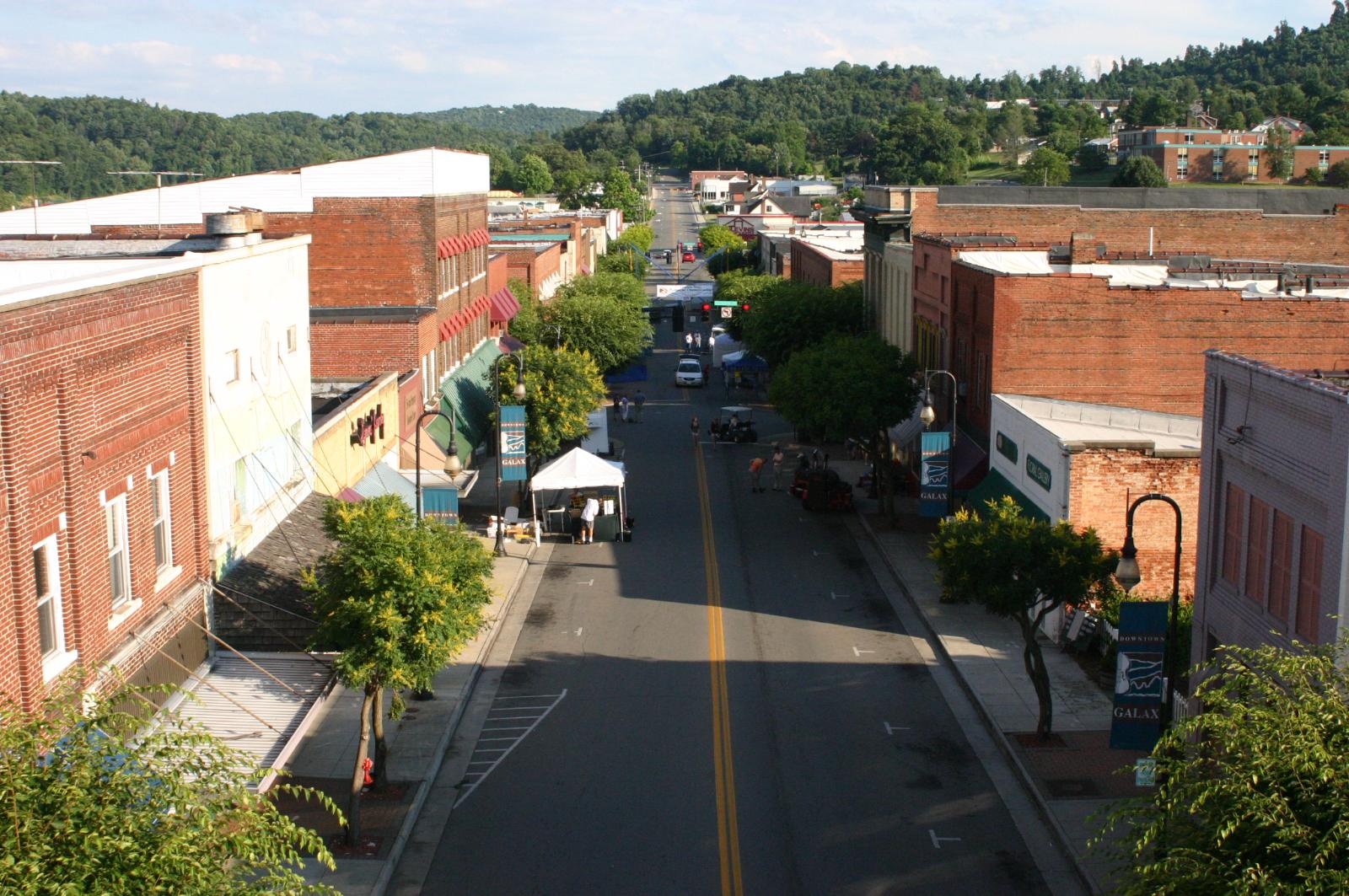
Galax sits in the Blue Ridge foothills and is known for its rich bluegrass and old-time music traditions. The town even hosts the annual Old Fiddlers’ Convention. But music alone can’t make up for the lack of transit, walkability, or senior support services. Retirees who don’t drive regularly may feel restricted here.
Galax might be ideal for active retirees deeply involved in the arts, but the day-to-day realities—especially for those with limited mobility—make it a less-than-ideal choice for aging in place comfortably.
Galax – ORS 28.52
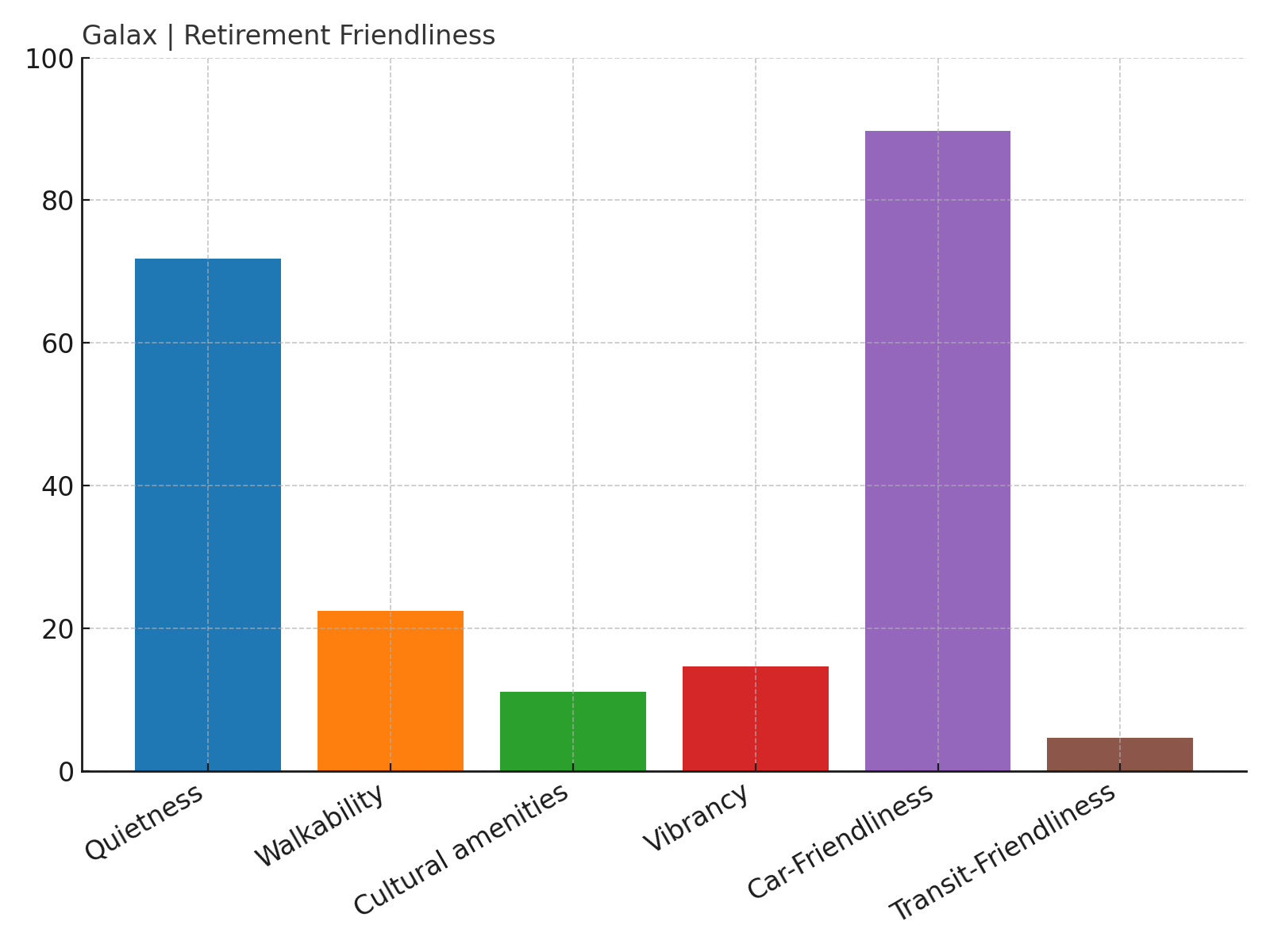
- Overall Retirement Score: 28.52
- Quietness: 71.82
- Walkability: 22.41
- Cultural amenities: 11.09
- Vibrancy: 14.61
- Car-Friendliness: 89.75
- Transit-Friendliness: 4.68
Galax’s ORS of 28.52 suggests a town with plenty of charm but not enough infrastructure for a fully supported retirement. It’s great for music lovers—less so for those needing easy, daily access to services and care.
4. Covington – Vibrant But Hard to Get Around
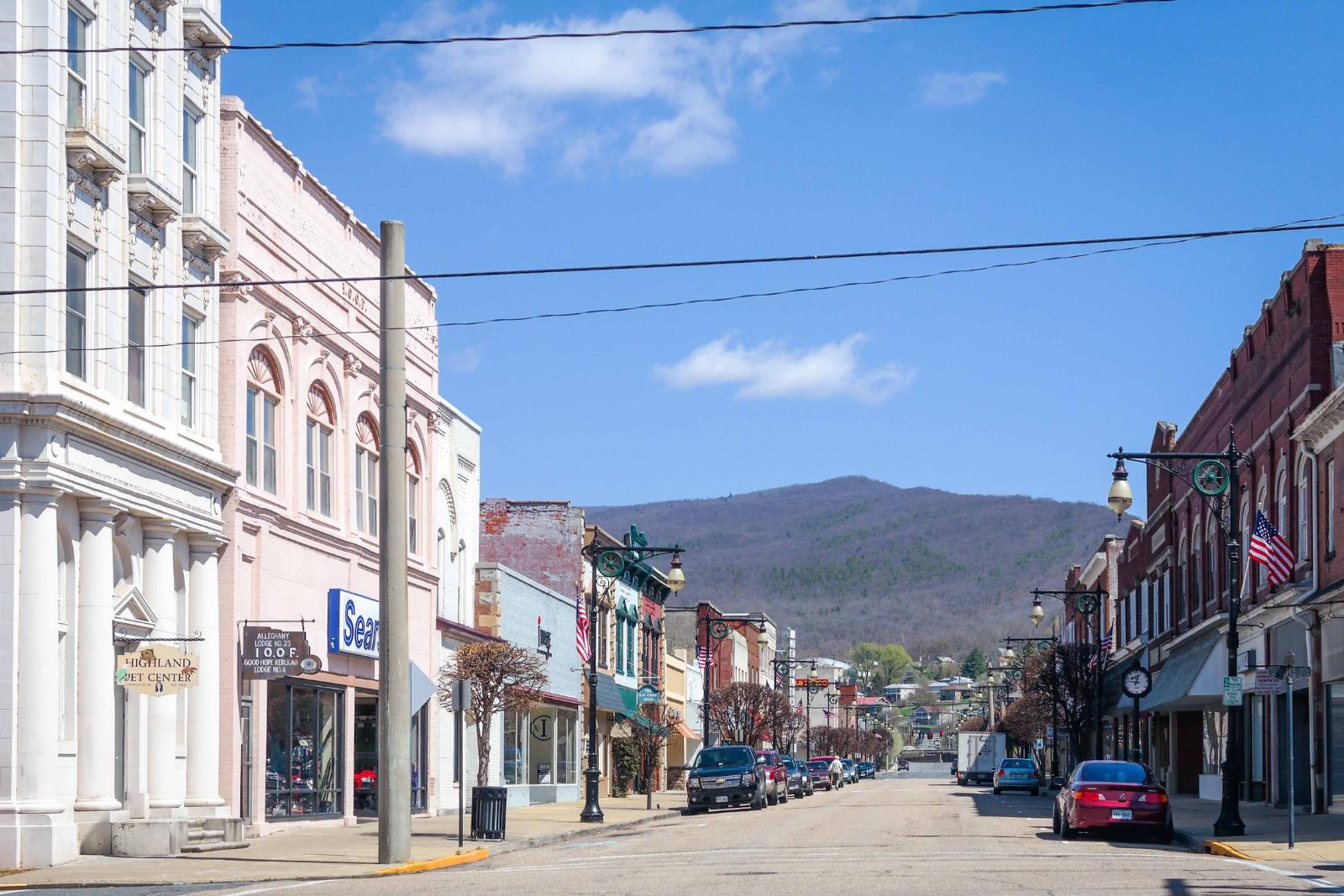
Covington, located near the West Virginia border, has a surprising amount of cultural activity and local pride. The historic downtown has seen some revitalization, and there are occasional community events. Still, retirees may find the transit and healthcare access frustrating. It’s the kind of place where owning a car is nearly essential.
The natural beauty of the surrounding Alleghany Highlands is a draw, but day-to-day convenience is limited. Retirees hoping for walkable neighborhoods or public transport will find themselves out of luck.
Covington – ORS 28.71
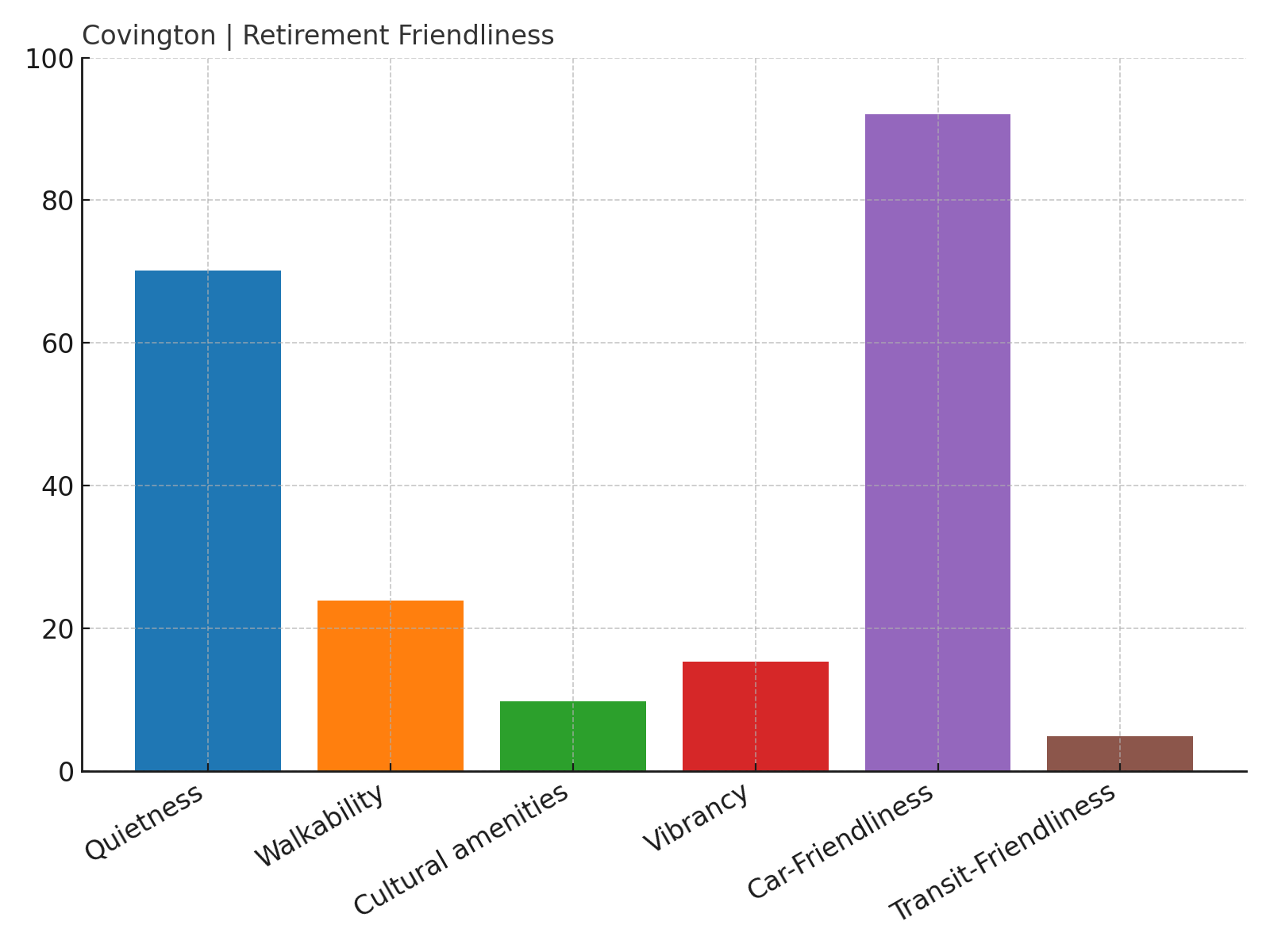
- Overall Retirement Score: 28.71
- Quietness: 70.13
- Walkability: 23.85
- Cultural amenities: 9.73
- Vibrancy: 15.32
- Car-Friendliness: 92.01
- Transit-Friendliness: 4.91
Covington earns an ORS of 28.71. It’s more vibrant than many towns on this list, but the reliance on driving and lack of robust healthcare options bring down its overall retirement appeal.
3. Norton – Energy Without Accessibility
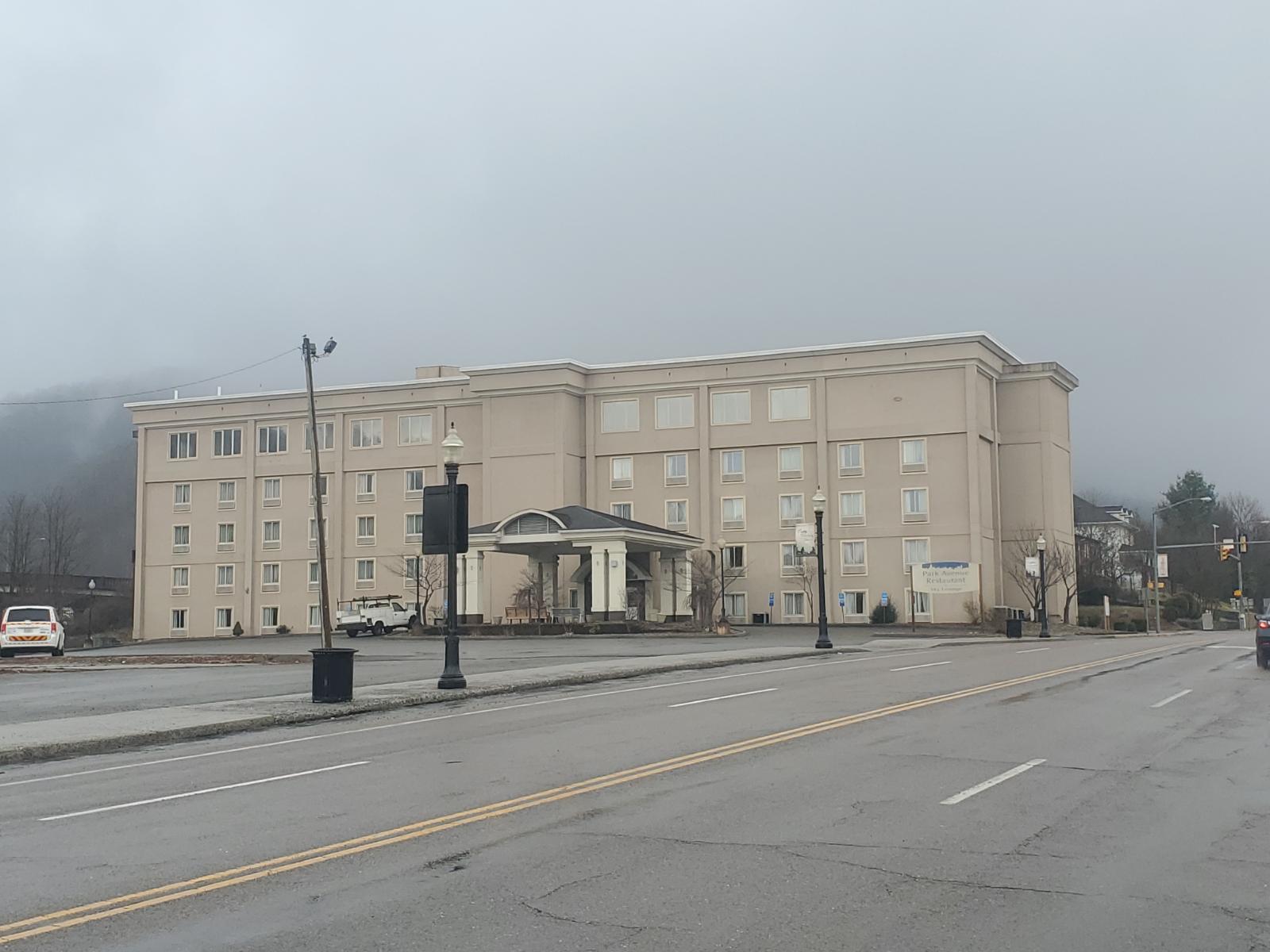
Norton is the smallest independent city in Virginia, tucked into the state’s mountainous far southwest. It offers scenic views and a more lively vibe than you might expect for its size, thanks in part to local festivals and nearby hiking trails. But when it comes to day-to-day life for retirees, the convenience factor is low. Public transit is minimal, and medical services aren’t as robust as you’d find in more developed areas.
While Norton may work well for nature enthusiasts and those who don’t mind driving, it’s not ideal for retirees who need walkable amenities or accessible healthcare. The town has charm and energy—but not quite enough support for an aging population.
Norton – ORS 28.97
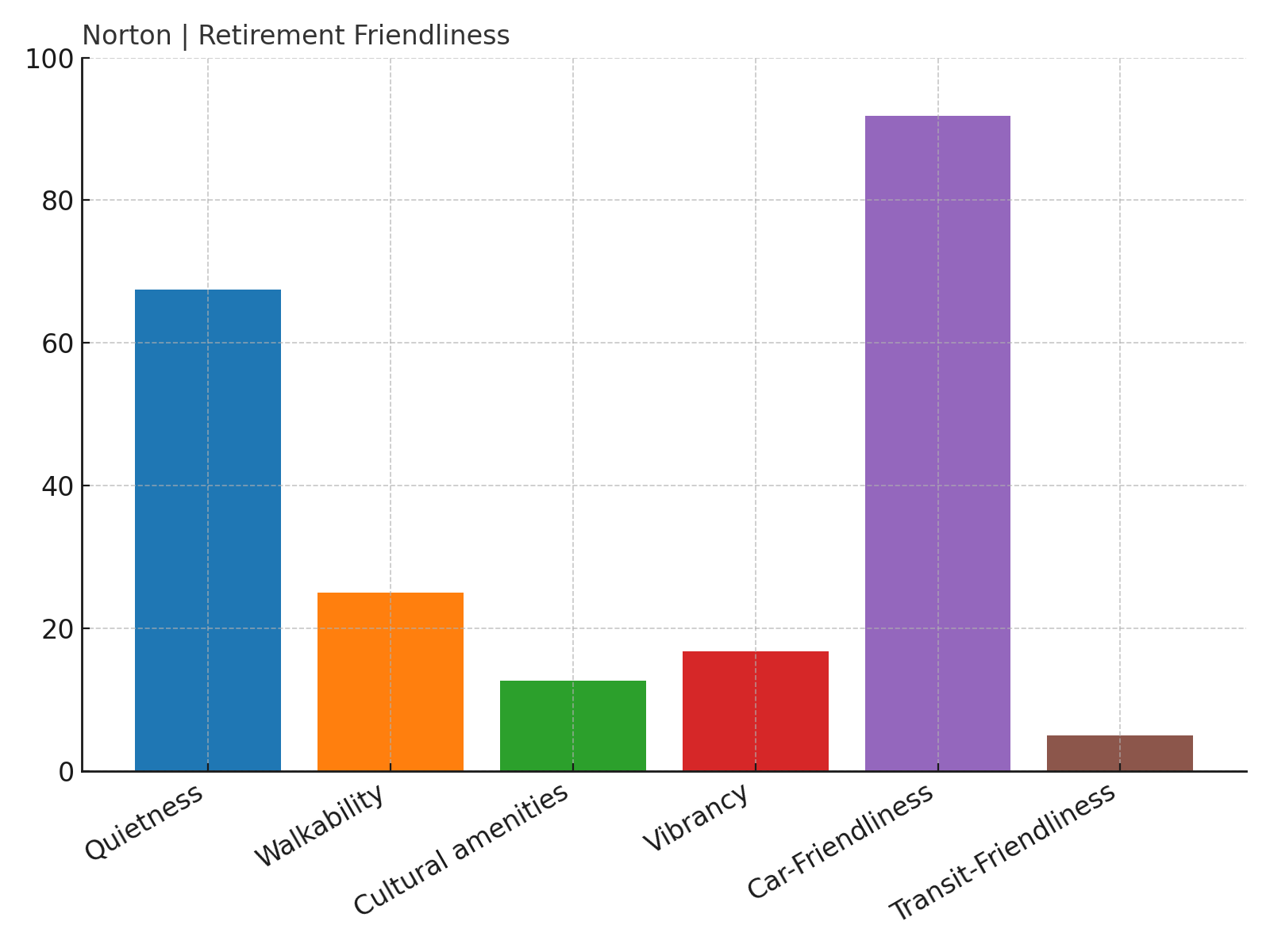
- Overall Retirement Score: 28.97
- Quietness: 67.48
- Walkability: 25.03
- Cultural amenities: 12.66
- Vibrancy: 16.77
- Car-Friendliness: 91.88
- Transit-Friendliness: 5.01
With an ORS of 28.97, Norton offers strong cultural appeal and decent walkability, but still misses the mark on key factors like public transport and senior services. It’s better for retirees who stay active and independent.
2. Danville – Affordable but Inconvenient
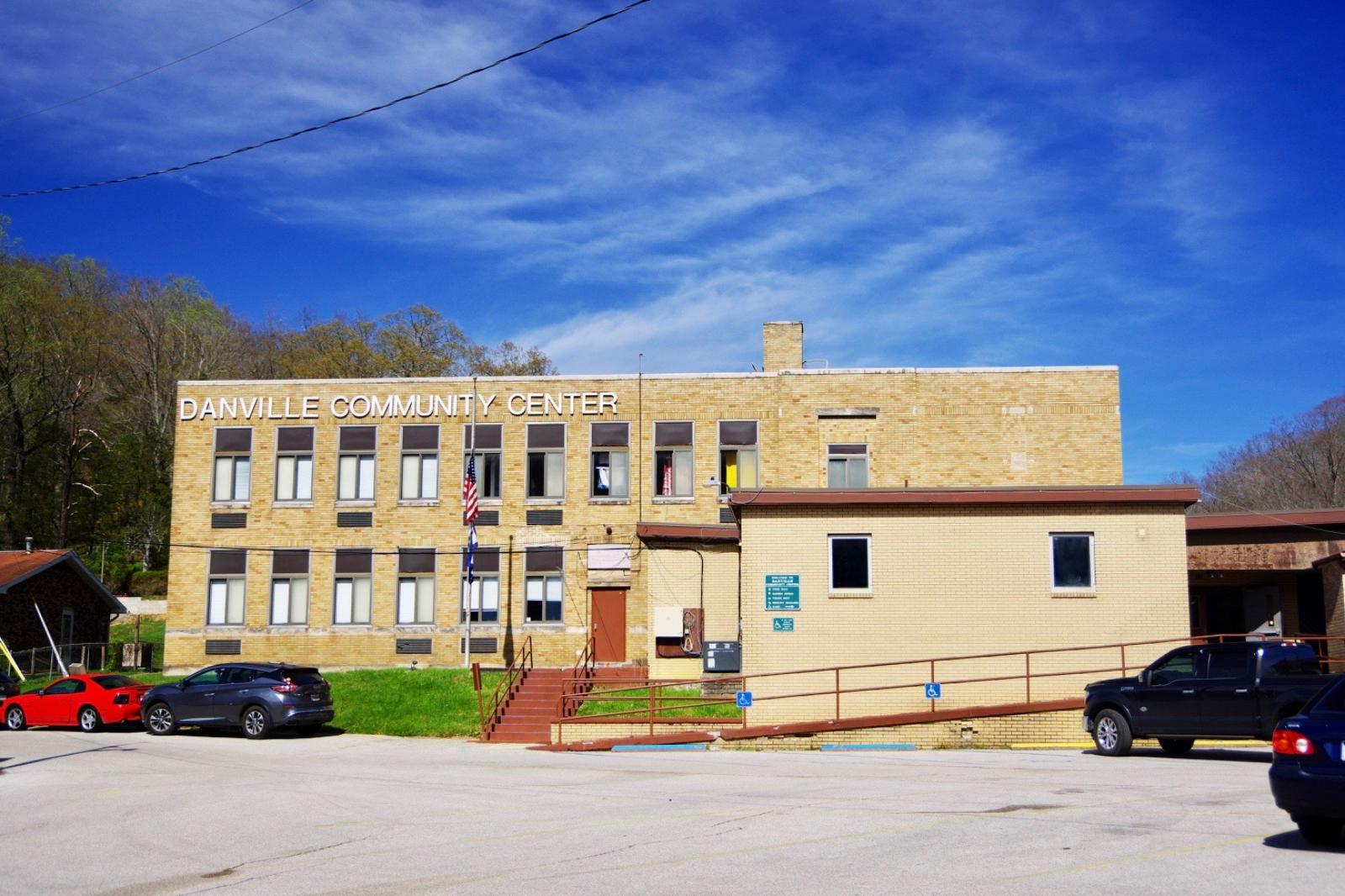
Danville, near the North Carolina border, has seen efforts to revitalize its riverfront and downtown areas in recent years. It’s affordable and has some cultural presence, but it also struggles with aging infrastructure and service gaps. While the walkability is better than most towns on this list, access to specialized care, transit, and day-to-day support is limited.
Retirees on a budget may find Danville attractive, but those prioritizing convenience and comfort may find themselves worn out by the constant need to drive or navigate uneven service quality.
Danville – ORS 29.25
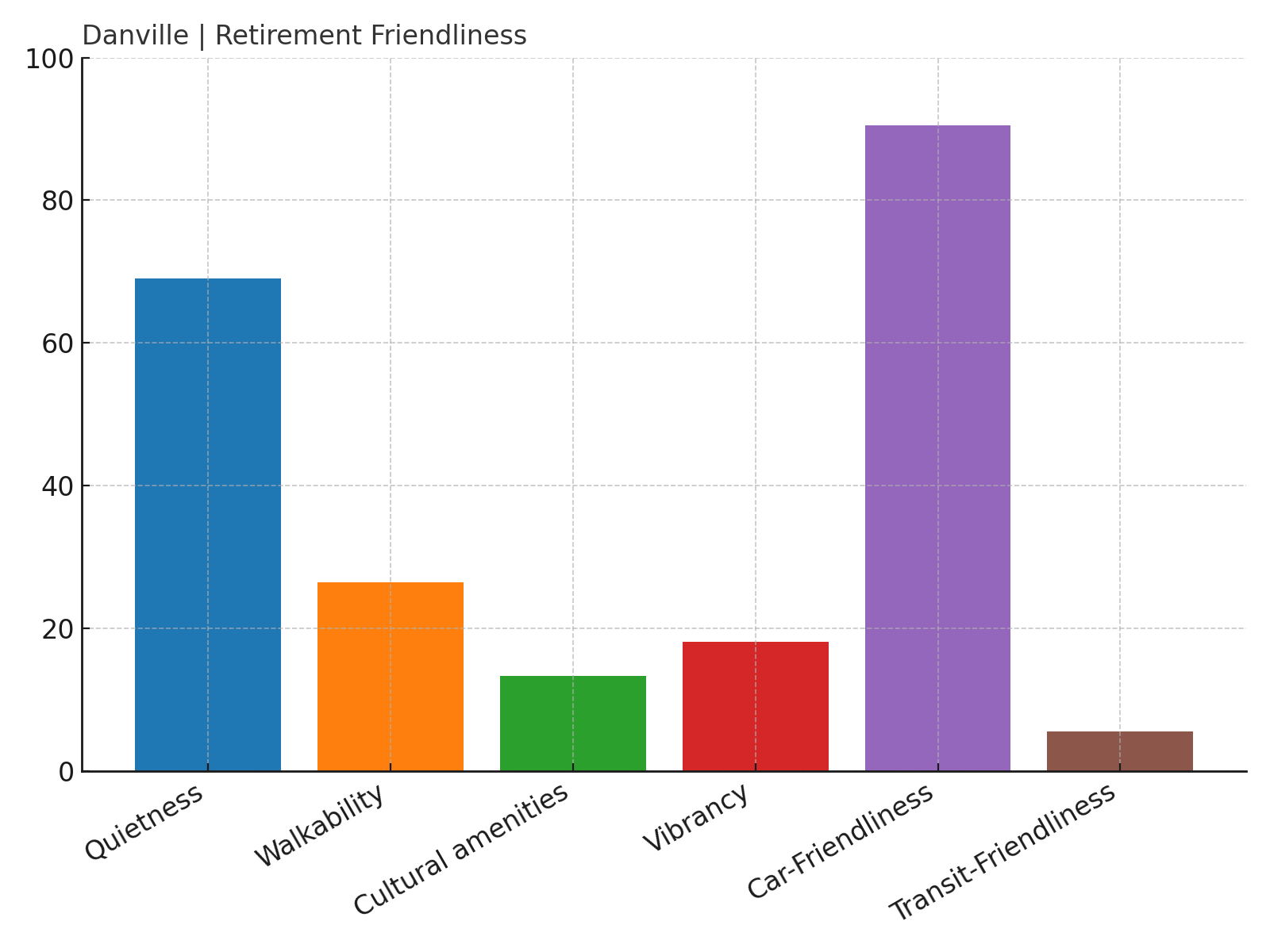
- Overall Retirement Score: 29.25
- Quietness: 69.02
- Walkability: 26.42
- Cultural amenities: 13.28
- Vibrancy: 18.14
- Car-Friendliness: 90.52
- Transit-Friendliness: 5.48
Danville earns a relatively high ORS of 29.25, but its uneven development and limited support services keep it from being a top-tier retirement destination. It’s a reasonable pick for those prioritizing affordability over ease of living.
1. Martinsville – Energetic, But Not Quite Retirement-Ready
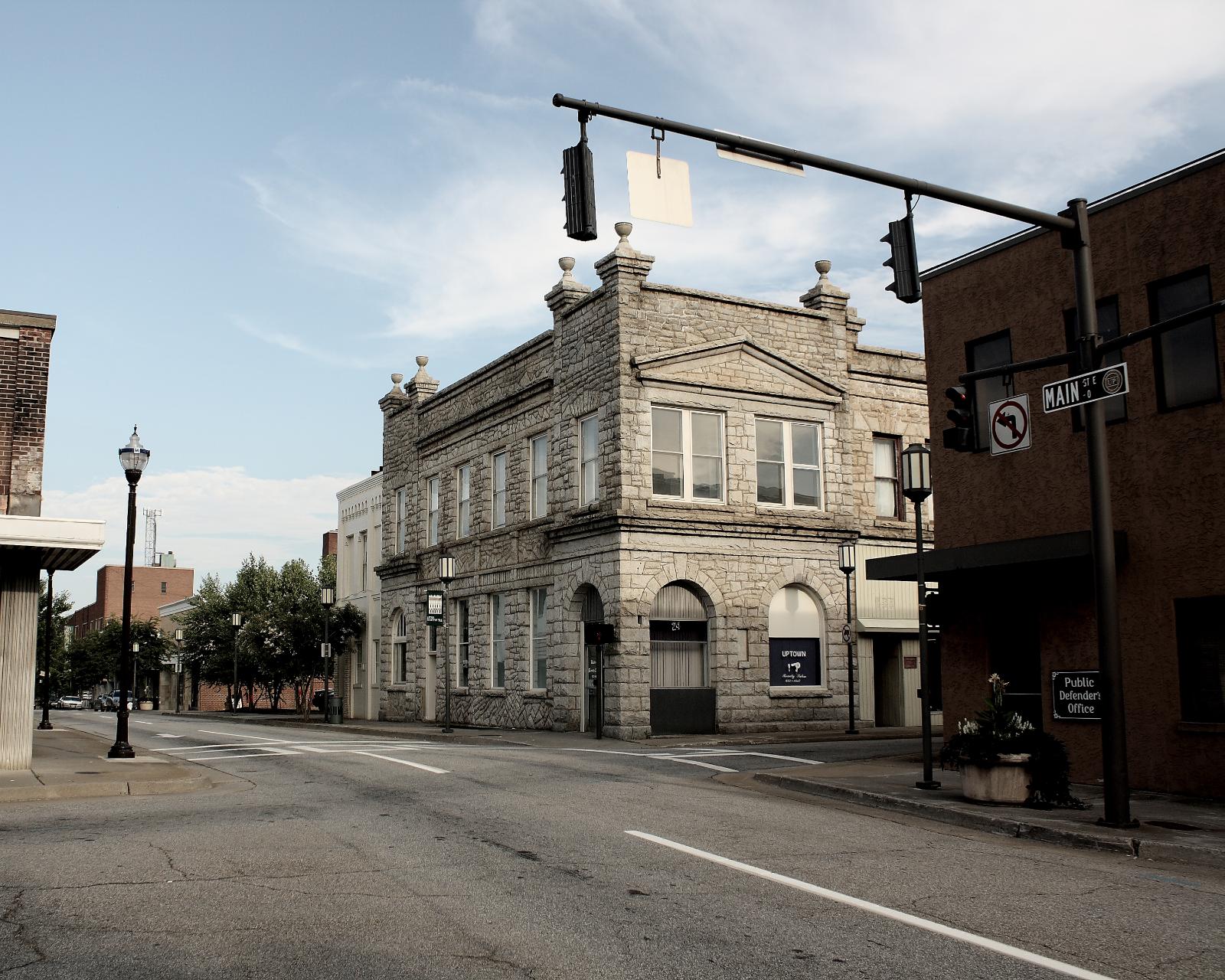
Martinsville tops this list with the highest ORS of the group, thanks to its higher walkability and lively downtown area. Located in southern Virginia, the town has a rich history in NASCAR and furniture manufacturing. In recent years, it’s made strides in community events and cultural offerings. However, the appeal fades somewhat for retirees who need reliable transport, strong medical networks, or senior-targeted programs.
There’s a lot to like here for younger retirees who want to stay engaged, but without deeper infrastructure improvements, Martinsville still falls short of being a true retirement haven.
Martinsville – ORS 29.88
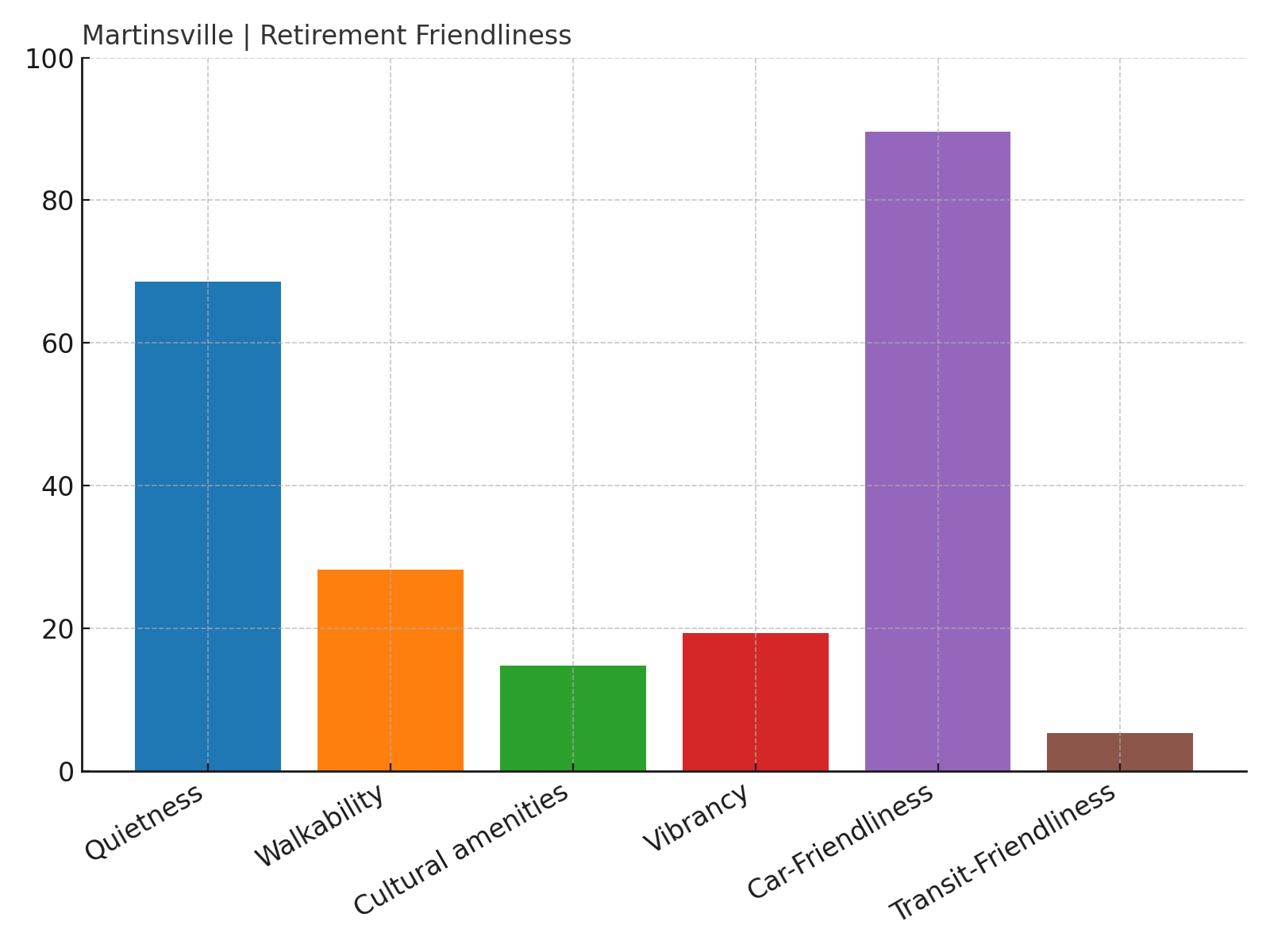
- Overall Retirement Score: 29.88
- Quietness: 68.63
- Walkability: 28.19
- Cultural amenities: 14.71
- Vibrancy: 19.30
- Car-Friendliness: 89.63
- Transit-Friendliness: 5.33
Martinsville leads this group with an ORS of 29.88. It’s the most dynamic option on the list—but still not quite ready for retirees who expect streamlined access, healthcare, and support systems in their next chapter.



